thursday, feb. 29, 2024
N • Living document
Mayor Ben Walsh spoke at an informational open house Wednesday evening about its Community Grid Vision Plan.
Page 1

celebrating 120 years
C • Grand Kyiv’s ‘Giselle’ Ukrainian “Giselle” ballet ran in Syracuse at the Palace Theater for one night only. The ballet company was founded in 2014.
Page 4
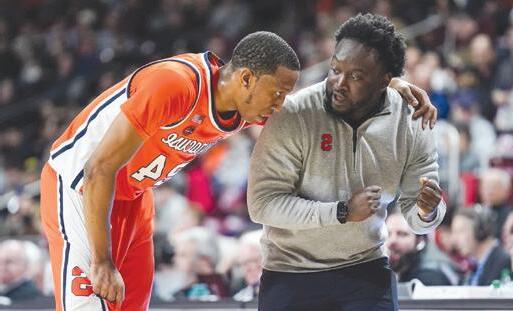
free
S • Rising the ranks
Syracuse assistant Brenden Straughn’s reputation in the DMV promises to extend SU’s evergreen recruiting pipeline.
Page 16
Mixed messages
Despite decades of research against facilitated communication, SU continues to promote the intervention
By Kyle Chouinard managing editor
Facilitated communication is supposed to help non-verbal people with disabilities communicate when they otherwise have not been able to. In a typical use of FC, the “facilitator” provides physical support for the “user,” sometimes by holding their wrist or other body part, as they point to a keyboard or other device.
FC’s main issue, however, according to numerous researchers and decades of studies, is that what is ultimately typed is not the thoughts of the person pointing. The facilitator, likely unintentionally, is the one controlling the message, said Ralf Schlosser, a professor of communication sciences and disorders at Northeastern University.
Despite research dubbing facilitated communication as pseudoscientific dating as far back as 1995 and a Daily Orange investigation into FC in 2016, Syracuse University continues to provide training and proliferate information on FC through the Center on Disability and Inclusion’s Inclusion and Communication Initiatives. James Todd, a professor of psychology at Eastern Michigan University, called the intervention’s continued existence at SU a “major embarrassment.”
“The ethical thing to do for the folks who are promoting this is to sit down and go, ‘We failed. We’ve been promoting something for decades that doesn’t work. We need to stop drawing in vulnerable parents with vulnerable children,’” Todd said. “Because no ethical clinician would foist pseudoscience on that kind of population.”
Schlosser authored two systematic reviews of facilitated communication — one published in 2014 and another in 2018. Results of the 2014 review indicated “unequivocal evidence for facilitator control” and that “FC is a technique that has no validity.”
In another review, Schlosser examined a study from Finland that had 11 children who use FC complete a

director
series of tasks like “object naming” and “reading.”
For “object naming,” when the facilitator working with the students could physically see the object, the students collectively went 33-for-36, answering 92% of the questions correctly. When the facilitator could not see the object, the success rate fell to 2%.
The disconnect between the results of numerous studies and some facilitators legitimately believing they are not authoring what is spelled out is likely due to the ideomotor effect, said Jason Travers, a professor of special education and applied behavior analysis at Temple University.
The effect, which is also used to explain how Ouija boards work, is the tendency of people’s bodies to behave inconsistently with mental intention or without attention and mental effort, Travers said.
Since 2020, SU’s ICI has hosted eight workshops on facilitated communication for potential facilitators. The two-day workshop, according to its event page on SU’s community calendar, “provides the opportunity to learn the techniques necessary to be a facilitator.” While the event page refers to the practice as “Typing to Communicate,” this phrase is used synonymously with facilitated communication on the ICI’s website.
Along with the event itself, ICI staff work with participants to create a plan “for continued support” after the workshop, according to the calendar
page.
It costs $100 to attend the virtual workshop, though there is no additional cost for a user to work with a paying facilitator during the sessions. Outside of scheduled training, the ICI also offers practice rooms with technology and “on hand” staff for $20 per hour-long session. The next workshop is scheduled for March 25.
Katharine Beals, an adjunct professor in Drexel University’s Autism Program, said that while she sees charging money to learn FC as “unethical,” she has become jaded to situations similar to SU’s.
“Nothing surprises me about the power of wishful thinking over evidence and also the behavior of people who want to sell something,” Beals said. “Unfortunately, I think this has become a very common practice in this country.”
Schlosser, having similar concerns, said it is unethical to act as if FC’s validity is still up for debate.
“It is not,” Schlosser said. “It is clear who the author is and it’s definitely not ethical to continue.”
The D.O. sent a series of questions to the ICI ranging from the content of its workshops to how SU works to ensure that what’s being communicated through FC is from the user.
The ICI did not answer The D.O.’s questions, instead opting to send a comment stating that the university is
see communication page 6
Advocacy interwoven within Disability Studies program history
By Kyle Chouinard managing editor
Editor’s Note: This article references historical documents and organizations related to disability, some of which contain mentions of slurs against people with disabilities.
Mercy Xie, a student in the Syracuse University Disability Law and Policy Program, said she has familiarized herself with two major models of disability: the medical model and the
social model. As put by Xie, the difference is that the medical model makes a disabled person’s body the issue while the social model makes the lack of accommodations in society the issue.
Growing up in China after losing one of her legs below the knee, she said the emphasis on the medical model made her feel like a burden to her family and school. At SU, however, Xie has examined herself through the lens of disability studies. “Disability Studies has really
empowered me for many years,” Xie said. When SU’s School of Education established its Disability Studies program in 1994, it was the first of its kind nationally. With the Americans with Disabilities Act being only 4-years-old and deinstitutionalization — through the closure of largely inhumane staterun mental health facilities — being realized, the ‘90s were a slate waiting to be rewritten for disability policy. SU community members had
worked for decades prior, both in their research and advocacy, to lay the groundwork for the ideas Xie and many other students now study within the university. The mixture of analysis and application of disability studies has stuck throughout the entire program’s existence. Despite its formation in the ‘90s, the principles of disability studies existed for decades earlier. Steven Taylor, who helped establish SU’s program and was named Centennial Pro-
fessor of Disability Studies in 2008, wrote “Before It Had a Name: Exploring the Historical Roots of Disability Studies in Education.”
In its foreword, Taylor wrote that the idea of disability as a social phenomenon emerged in at least the 1960s.
“To regard disability as a social construction or creation is not to deny human variation,” Taylor wrote. “Variations according to ability do not see disability studies page 7
on campus
bridget overby presentation
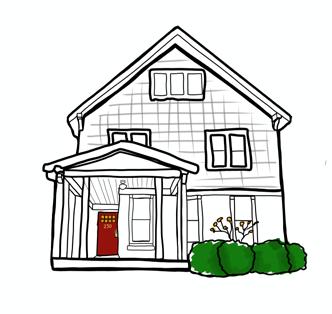
Editor@dailyorange.com
News@dailyorange.com
Opinion@dailyorange.com
Culture@dailyorange.com
Sports@dailyorange.com
Digital@dailyorange.com
Design@dailyorange.com
BUSINESS 315-443-2315
The Daily Orange is an independent, nonprofit newspaper published in Syracuse, New York. The editorial content of the paper — which started in 1903 and went independent in 1971 — is entirely run by Syracuse University students.
The D.O., a 501(c)(3) nonprofit, is editorially and financially independent from SU, and the paper receives no funding from the university. Instead, The D.O. relies on advertising revenue and donations to sustain operations.
This fall, the paper will be published Thursday when SU classes are in session. The D.O.’s online coverage is 24/7, including while SU is on break.
To show your support to The D.O.’s independent journalism, please visit dailyorange.com/donate. Donations are tax deductible.
how to join us
If you are a Syracuse University or SUNY-ESF student interested in contributing to The D.O. on either its advertising or editorial teams, please email editor@dailyorange.com.
corrections policy
The D.O. strives to be as accurate in our reporting as possible. Please email editor@dailyorange.com to report a correction.
letter to the editor policy
The D.O. prides itself as an outlet for community discussion. To learn more about our submission guidelines, please email opinion@dailyorange. com with your full name and affiliation within the Syracuse community. Please note letters should not include any personal information pertaining to other people unless it is relevant to the topic at hand. All letters will be edited for style and grammar.


INSIDE
The best quotes from sources in today’s paper.
NEWS
“They’ll have those tools available. So, for us as instructors, it’s our task to teach them how to use them.” - Assistant professor Sebastian Tideman-Frappart on the use of AI Page 1
CULTURE
“Then, I also go to school here, so it’s like, ‘Baby bleeds orange through and through.” - Junior Janna Van Vranken on her Syracuse-themed tattoo Page 6
OPINION
“Art is unique in its ability to spread awareness as it can evoke emotions and spark human connection with the environment more effectively than a data set.” - Izzy Kaufman, columnist Page 10
SPORTS
“I could never see myself sitting in a lab or behind a desk and that's where wanting to be an agent came in.” - Emma Ward on becoming an FBI agent Page 16
COMING UP
Noteworthy events this week.
WHAT: Cross Country Skiing and Snowshoeing at Drumlins
WHEN: March 1, 3 - 5 p.m.
WHERE: Goldstein Student Center, 201ABC
WHAT: The Untapped Billion - Redefining Sports Fandom
WHEN: March 1, 2 - 3:30 p.m.
WHERE: Newhouse 1, 102
WHAT: Tennity Ice Skating Pavilion: Open Skate
WHEN: March 1, 12 - 10 p.m.
WHERE: Tennity Ice Skating Pavilion

about
The D.O. is published weekdays during the Syracuse University academic year by The Daily Orange Corp., 230 Euclid Ave., Syracuse, NY 13210. All contents Copyright 2023 by The Daily Orange Corp. and may not be reprinted without the expressed written permission of the editor-in-chief. The Daily Orange is in no way a subsidy or associated with Syracuse University. All contents © 2023 The Daily Orange Corporation
2 february 29, 2024
City holds second Community Grid Vision Plan open house
By Alec Sturm staff writer
Mayor Ben Walsh spoke at a city of Syracuse informational open house Wednesday evening about its Community Grid Vision Plan, which it announced Feb. 21. The plan is a guide for city and state officials to follow as the community grid is developed.
The event, held at Lincoln Middle School, was the second of two open houses this week — the first held at STEAM at Dr. King Elementary School Tuesday night.

The Community Grid Vision Plan is a drafted proposal of over 60 suggested quality-of-life improvements in Syracuse, including biking and pedestrian routes, more efficient buses and public transportation as well as improved streets — both existing and new streets created by the I-81 Viaduct Project and community grid, according to the plan. The plan has yet to be approved, unlike the I-81 Community Grid, which the New York State Department of Transportation announced its approval of in April 2019. Rather, the plan is a long-term “living document” being drafted of possible changes to the city, which could be years or even decades away, said Joshua Frank, an urban design and town planner at Dover, Kohl & Partners — a Florida-based town planning firm. The city paid Dover, Kohl & Partners $500,000 of Ameri can Rescue Plan funds to create the vision plan, according to WRVO.
“In order to have a productive conversation about this vision plan, it’s critical that you accept the reality that the community grid plan is happen
ing,” Walsh said. “Whether you like it or not — I don’t say that in an antagonistic way — it’s just the reality that we are in right now. The issue has been debated, it’s been litigated.”
Frank, who led the open house, spoke for a halfhour detailing each proposed change and opened a Q&A session with community members.

In the University Hill neighborhood, the vision plan looks to implement biking and pedestrian paths down Irving Avenue, Van Buren Street and Henry Street to connect Oakwood Cemetery to Almond Street, the latter of which is viewed as a potentially transformative street for the city, Frank said.
The organizers behind the vision plan envision Almond Street as a boulevard comparable to Commonwealth Avenue in Boston with expanded investment in walkability, storefronts and buildings with affordable housing, Frank said.
“Almond Street, we think, has the potential to be one of the best streets in North America. I’m not being hyperbolic when I say that,” Frank said.

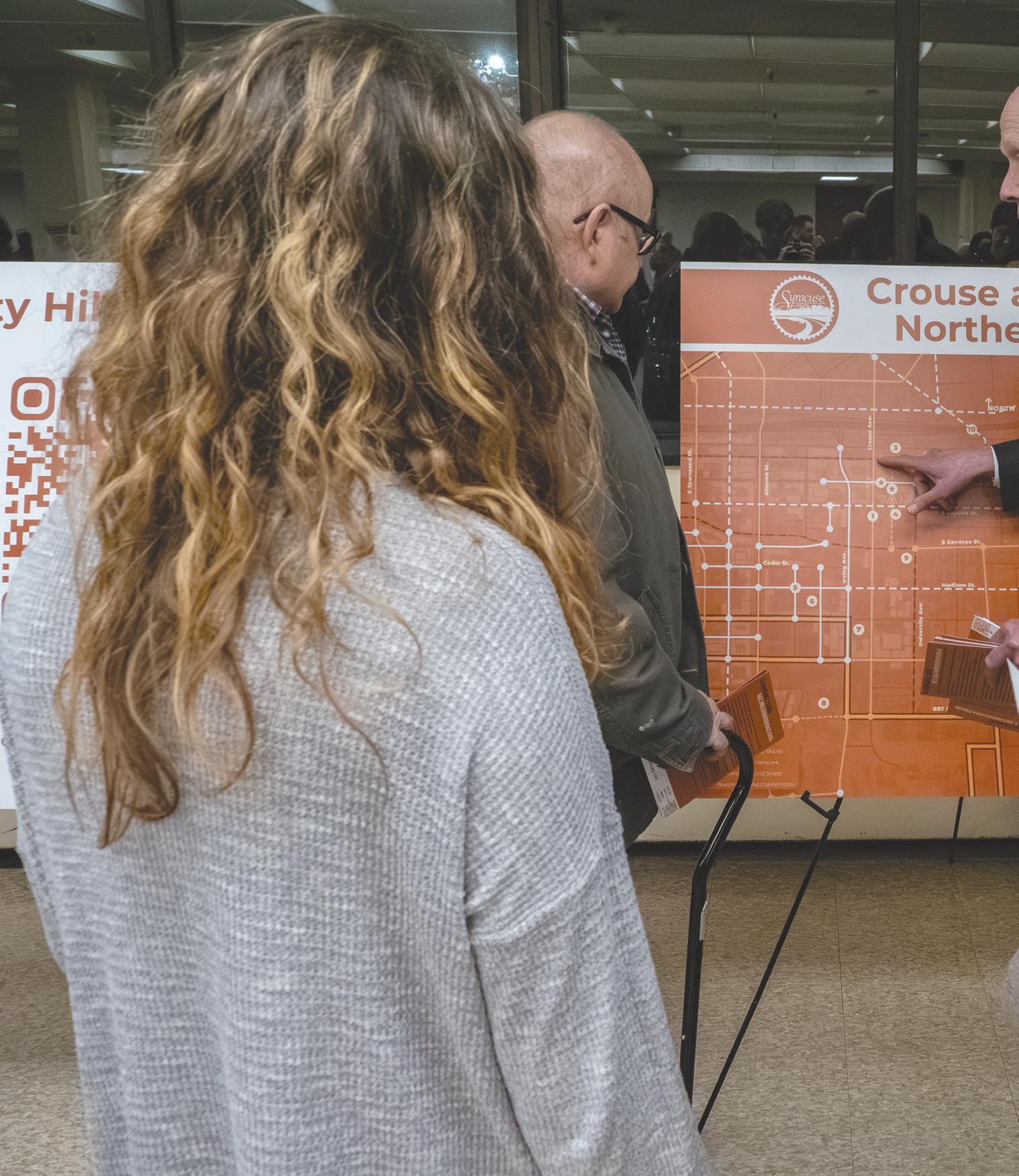
The
The plan also includes a proposal to connect Irving Avenue, Forestry Drive and Sims Drive to the Smart 1 Bus Rapid Transit project along the east side of Syracuse University’s campus. The BRT project aims to prioritize buses throughout Syracuse, with bus-only traffic lanes and streetlights that allow buses to cross before passenger vehicles, Frank said. Though the vision plan is not primarily focused on the University Hill neighborhood, some student attendees said they were worried about how the
CTLE conversation helps SU faculty navigate ‘AI misuse’
By Bengt-Erik Nelson contributing writer
Syracuse University’s Center for Teaching and Learning Excellence held a “Setting and Managing Boundaries for Students’ Use of Artificial Intelligence” conversation Wednesday afternoon, which looked to foster open conversation among SU faculty about the emerging prominence of AI in education.
During the event, CTLE hosted two keynote speakers — Roger Hallas, an associate professor in the English department and Laura Lisnyczyj, an assistant teaching professor in the languages,
literatures and linguistics department — to speak about their experiences interacting with AI as instructors. Around 25 faculty attendees also discussed how they are navigating the changing AI landscape.
Throughout the presentation, Hallas highlighted three areas of inquiry: setting expectations, developing AI-resistant assignments and the dynamics of AI detection. Hallas said transparency around AI is important in ensuring students have a clear idea of what is allowed in class.
“Whatever you decide, in terms of whether AI cannot be used in any context, whether AI can be used in some context, whether AI is going to
be specifically engaged with in assignments … be clear upfront about those expectations,” Hallas said, “because transparency in curriculum and syllabi is a major issue of accessibility.”
Hallas also explained strategies to create “AIresistant assignments,” such as utilizing close reading, assignments that revolve around students’ personal experiences and creating assignments with “scaffolding” — where students submit drafts and edits of their work over time.
Hallas said that students tend to “misuse” AI resources when facing hard deadlines, which often results in procrastination.
Hallas said dealing with AI detection and
accountability is “mentally and emotionally draining” for both the student and instructor, which is why he tries to tackle issues of AI detection without “breaking the trust between student and teacher.”
“What I ask the students to do is to talk about their process. How did you come up with the idea of this paper, so rather than go in with ‘Your ChatGPT score is 87%, how do you account for that?’ (work) through how they got the idea of the paper,” Hallas said.
An SU resource webpage, last updated in January, established guidelines for AI usage
see ai page 7
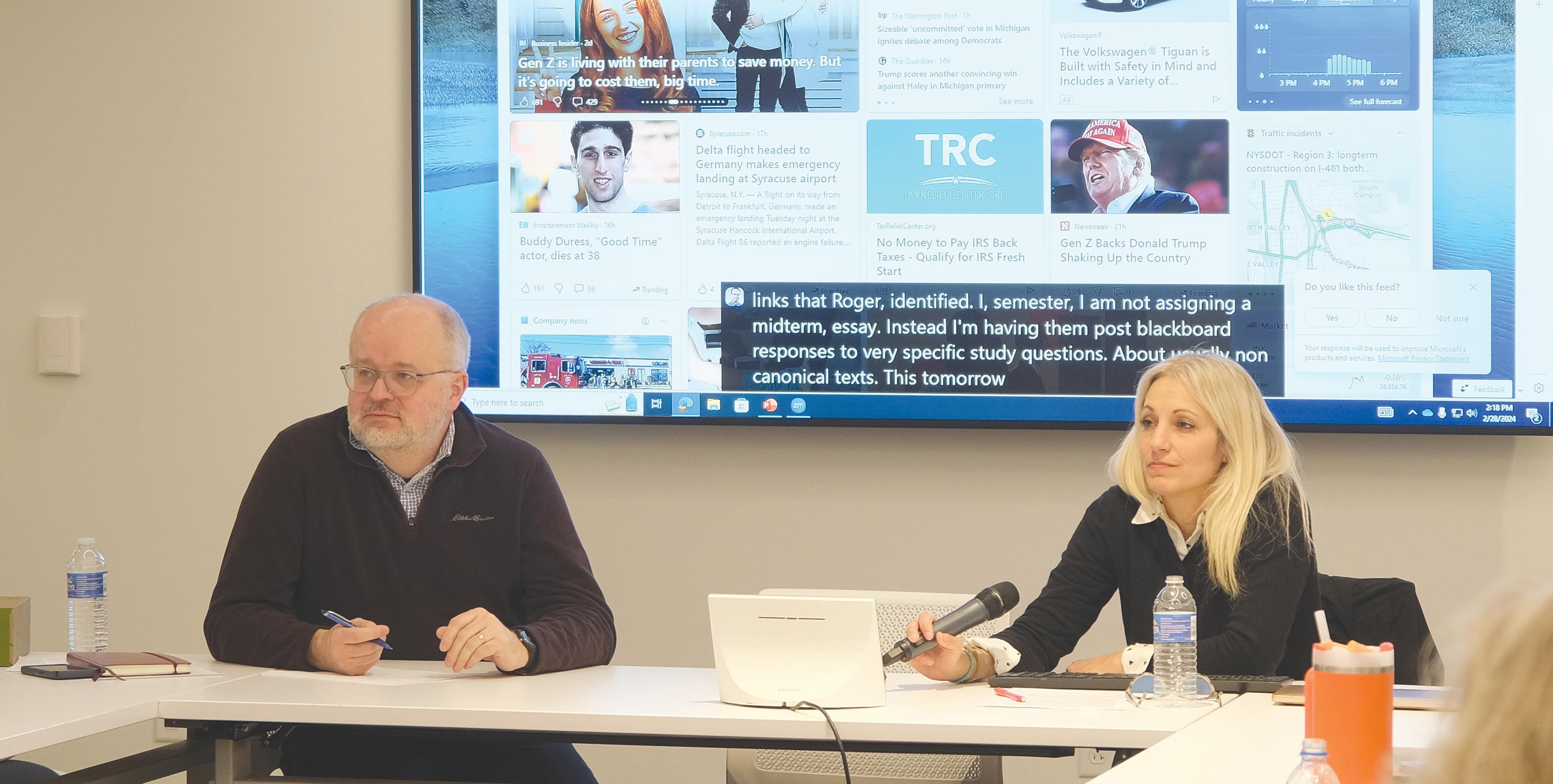
NEWS dailyorange.com news@dailyorange.com february 29, 2024 3 city
plan will displace Syracuse residents in the South Side neighborhood.
on campus
I-81 Community Grid Vision Plan discussion included a feedback session where residents expressed their questions and concerns. lars jendruschewtiz asst. photo editor roger hallas (left) and laura lisnyczyj(right), both Syracuse University faculty members, moderate a discussion about managing emerging AI technologies. They also highlighted strategies to prevent “AI misuse.” maxine brackbill photo editor
see grid page 7
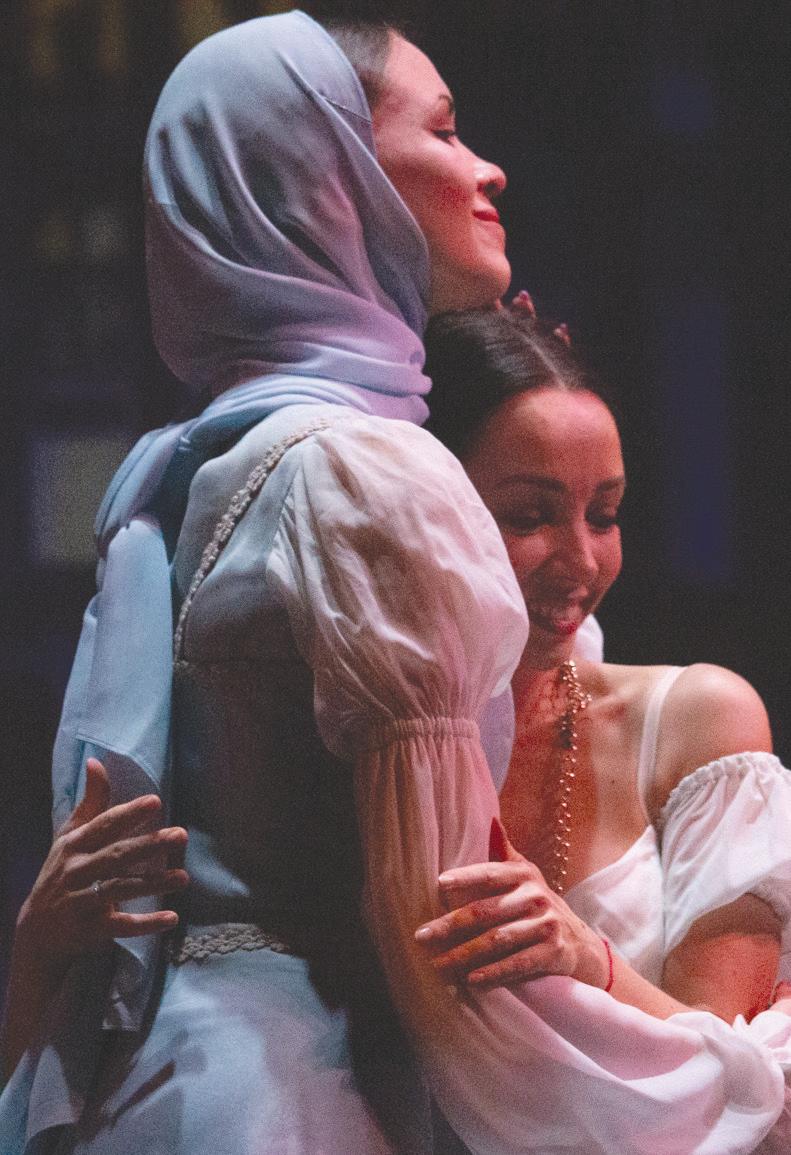
Palace

The Grand Kyiv Ballet comes to Syracuse Pirouettes
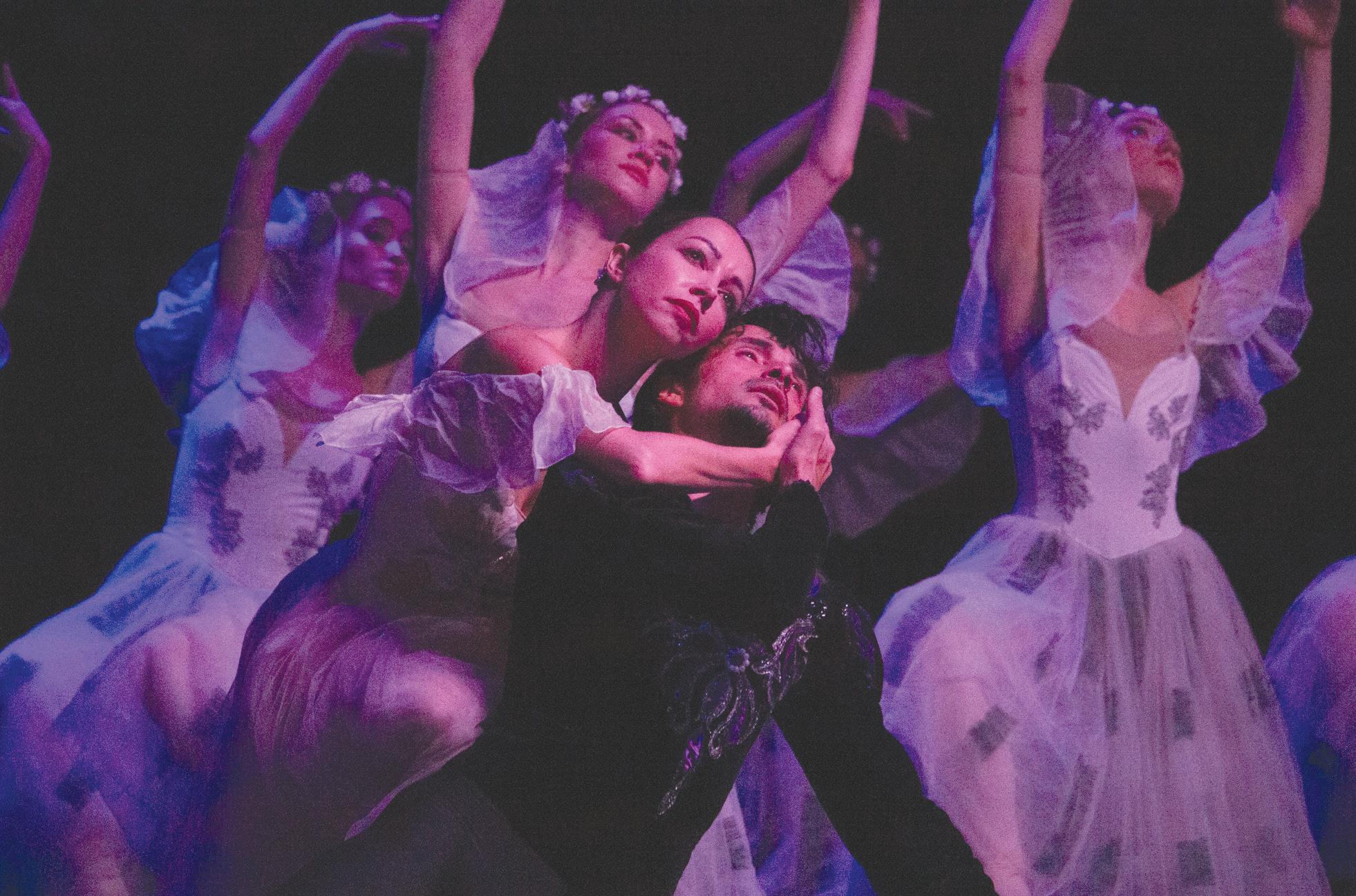
4 february 29, 2024
GISELLE (LEFT) holds ALBRECHT (RIGHT) as he mourns her death. The Grand Kyiv Ballet has organized touring performances of Ukranian dancers since 2014.
The Grand Kyiv Ballet’s rendition of “Giselle” visits the Palace Theatre Tuesday night.
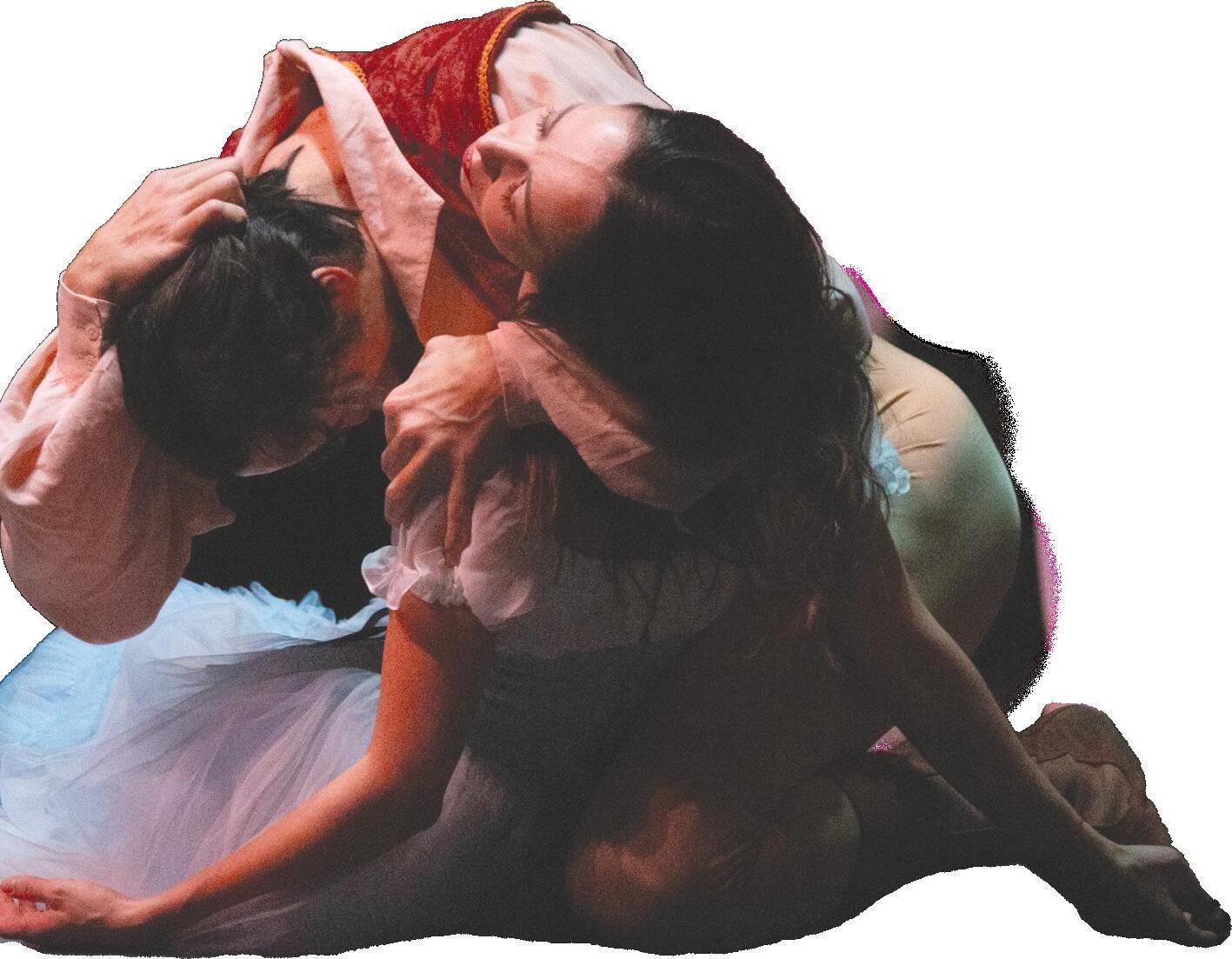
Pirouettes
Syracuse to share the story
of ‘Giselle’
 Story by Ava Lombardi asst. copy editor
Photos by Cassandra Roshu photo editor
Story by Ava Lombardi asst. copy editor
Photos by Cassandra Roshu photo editor
As the house lights turned on and Ukrainian ballerina Kateryna Kukhar took her final bow at Syracuse’s Palace Theatre on Tuesday night, she received a standing ovation from the audience who attended the Grand Kyiv Ballet’s performance of “Giselle.”
“Theater is like a church,” Kukhar said. “When people see performances, they live this small life with the artists. Their soul and mind is purified.”
Founded by ballet star Oleksandr Stoianov, the Grand Kyiv Ballet organizes touring performances of Ukrainian dancers. Since its creation in 2014, the company has presented legendary ballets around the world, such as “Snow White and the Seven Dwarfs,” “Children of the Night” and now “Giselle,” which marked their first performance in Syracuse.
“Giselle” dates back to 1841 and follows a young peasant girl of the same name as she falls in love with an aristocrat named Albrecht, who is disguised as a commoner. Upon learning of Albrecht’s true identity, Giselle dies of a broken heart but still returns to save Albrecht from the same fate.
“Giselle” has been performed by hundreds of companies and is known as one of the most famous romantic ballets of all time. Stoianov acknowledges the show’s rich history and said that the Grand Kyiv Ballet’s performance is “just one take” on the story.
As principal dancer of the ballet company, Stoianov plays Albrecht in the Grand Kyiv’s adaptation of the show. The character of Giselle is played by Kukhar, the company’s prima ballerina, who said that every night’s performance is “different than the last.”
“(“Giselle”) is a story that never dies,” Kukhar said. “It is full of mysticism, passion, love and drama.”
The Grand Kyiv Ballet’s tour of “Giselle” takes place amid the two-year anniversary of Russia’s invasion of Ukraine. For Stoianov and Kukhar, the ongoing conflict has made the ballet even more meaningful.
“For us, it’s very important to bring our culture to all countries,” Stoianov said. “We want people to know that we are still going, that we still need support from our allies. We are showing them that we are strong and we are powerful.”
Similarly, Kukhar believes that “art is the most powerful weapon.” She feels particularly moved by one of the last scenes in “Giselle.”
“At the end of the performance, there is a sunrise. For us, this is a symbol for all Ukrainian people,” she said. “All of the darkness, all of the bad things are disappearing, and we can see a future for all Ukrainian children.”
Community members of all ages attended the Grand Kyiv Ballet’s Syracuse performance Tuesday. The Palace Theatre’s employees and show attendees highly anticipated the ballet, said Jackie Dougherty, the theater’s administrator and bookkeeper.
Dougherty said the theater feels “honored” that the Grand Kyiv Ballet company chose to perform in Syracuse.
“It’s a professional ballet from the Ukraine and we understand that, in the political sense, they have a lot going on in their country that’s pretty devastating,” Dougherty said. “Them choosing to come here and share their talents with us, to share bits and pieces of their culture with us, is very special.”
As they carry on with their tour, Stoianov and Kukhar hope to continue delivering messages of confidence and resilience to their audiences. Both dancers believe that their art can “give (Ukrainian) people faith about the future.”
“We want to show people that there is more to Ukraine than this war,” Stoianov said.
“As artists, this is what we can do now. This is our mission.”
aalombar@syr.edu
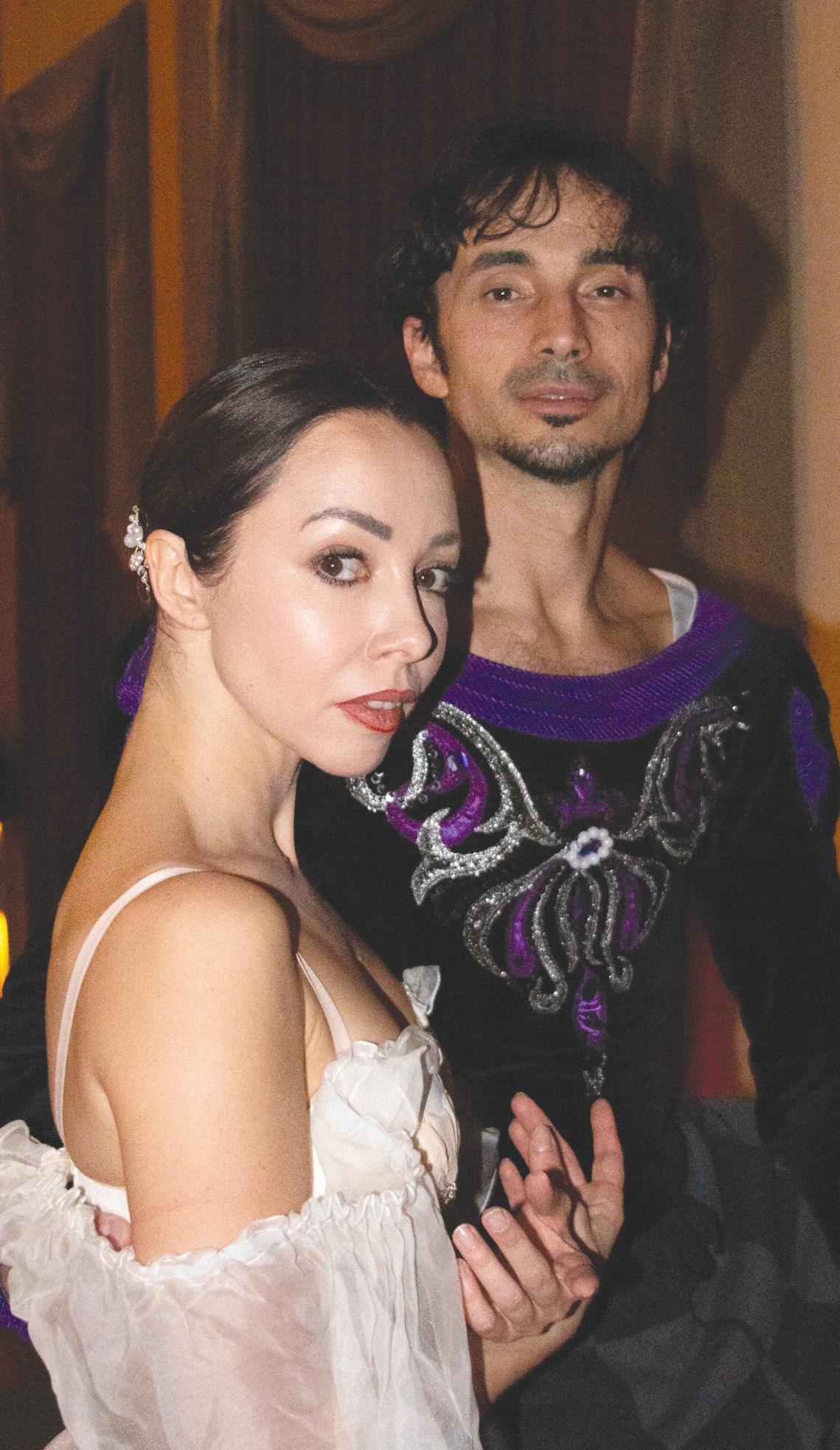
february 29, 2024 5
While Albrecht has fallen in love with Giselle, he is already engaged to Bathilde — the Duke of Courland’s daughter.
KATERYNA KUKHAR (LEFT) AND OLEKSANDR STOIANOV (RIGHT) co-starred, playing the lead roles of Giselle and Albrecht.
Hans Kundnani reflects on new book ‘Eurowhiteness’ at SU
By Ahna Fleming asst. news editor
Syracuse University’s Center for European Studies at the Moynihan Institute of Global Affairs welcomed Hans Kundnani, a current visiting fellow at New York University’s Remarque Institute, Wednesday evening for a discussion of his new book: “Eurowhiteness: Culture, Empire and Race in the European Project.”
Kundnani’s book sets forth an argument about the European Union — which, he said, is interchangeable with Europe — and European identity. He said his argument is “quite different” than the histories that the EU “tells about itself” and that European studies tell about European expression.
“European identity and the (EU) has a lot more to do with whiteness than we think,” he said. “I think there’s a European history of whiteness (separate from the Anglo American history) and it’s a real gap. My book doesn’t really fill it, but it’s trying to sort of say, ‘Look, we need to think about the history of whiteness in the European context.’”
The origin of the EU, which Kundnani calls “the original sin of European exploration,” was European integration — a “colonial project” by which France and Belgium could hold onto their remaining colonies in West and Central Africa, he said. He does not mean to suggest that this is the whole story, but said it is an impor-
committed to diversity, inclusion and accessibility and that it is proud of “its long history of supporting teaching, research, and other scholarly activities that advance, support, and align with these core values.”
“The ICI’s commitment to communication and inclusion for individuals so often at risk for marginalization and exclusion is an issue of civil and human rights and very much in line with the mission of Syracuse University and the School of Education,” it wrote. “The ICI’s work is guided by standards of best practice and our research has undergone rigorous peer review and is held to the same high standards of all scholarly research.”
The university itself did not respond to a request for comment on whether it endorsed the practice and proliferation of facilitated communication at SU.
Speaking to The D.O. in 2016 regarding the practice of facilitated communication, Howard Shane, now the director of Boston Children’s Hospital’s Autism Language Program, said the university should be ashamed.
“They’ve never asked the fundamental question: Is this real?” Shane then told The D.O.
Neither Todd, Schlosser nor Travers blamed parents for their interest in FC.
“Parents care deeply about their children,” Travers said. “They want to be able to communicate with their children. They want to understand the thoughts and needs and feelings of their children.”
While Todd believes parents should be vigilant about their children, he said parents are not in a good position to discern the legitimate from the pseudoscientific, especially when the information
tant part that has been “written out (of history) until very recently.”
Kundnani, who studied philosophy and German at Oxford University and journalism at Columbia University’s Graduate School of Journalism, was previously the director of the Europe Programme at the Royal Institute of International Affairs, commonly known as the Chatham House, in London — an international affairs think tank.
Prior to his time at Chatham House, Kundnani was a full-time journalist. He continues to write regularly for newspapers, including The Guardian, and has written for various other newspapers and magazines like The New York Times and The Wall Street Journal. He has also written books such as “Utopia Or Auschwitz” and “The Paradox of German Power.”
Kundnani said that the EU thinks about itself based upon what he calls “internal lessons” — lessons learned from centuries of conflict between Europeans that ultimately led to World War II and the Holocaust.
“But what is missing is any sense of what I call the ‘external lessons’ of European history,” Kundnani said. “Not so much of what Europeans have done to each other, but what they’ve done to the rest of the world … in particular, Africa and the Middle East … obviously, European colonialism.”
Kundnani said he doesn’t think it’s a coincidence that this “forgetting” takes place within European history, and that European integration granted Europeans “an escape from the memory
is coming from a supposed expert working out of a major university such as SU.
Schlosser said professionals need to be held to a higher standard, abiding by their professional organization’s code of ethics no matter the field.
“If they don’t follow what’s evidence-based, then we’re in trouble,” Schlosser said.
One evidence-based tool for non-verbal people — and anyone having trouble with speech or language — is augmentative and alternative communication, or options for communicating outside of speaking. According to the American Speech-Language-Hearing Association, AAC options can range from writing and pointing at photos to more high-tech forms like using an iPad or a computer with a “voice.”
In the first sentence of the ICI’s page on “Typing to Communicate,” the group states that facilitated communication is a form of AAC. Schlosser — who, according to Boston Children’s Hospital, has “published extensively” on AAC — disagreed with the ICI’s claim.
“They like to think that they’re under our umbrella, but we don’t think they are because the message is not produced independently,” Schlosser said.
Travers agreed, saying facilitated communication was “unequivocally” not a type of AAC.
Outside of authorship and claims that facilitated communication is AAC, Travers also took issue with some of the assumptions necessary for FC to, in theory, operate.
“One foundational assumption of facilitated communication is that the person is fully literate even though they’ve never received any form of formal literacy instruction,” Travers said. “Typically developing children require years of daily instruction for hours at a time to acquire literacy skills. And even then, many, many children continue to struggle with literacy.”
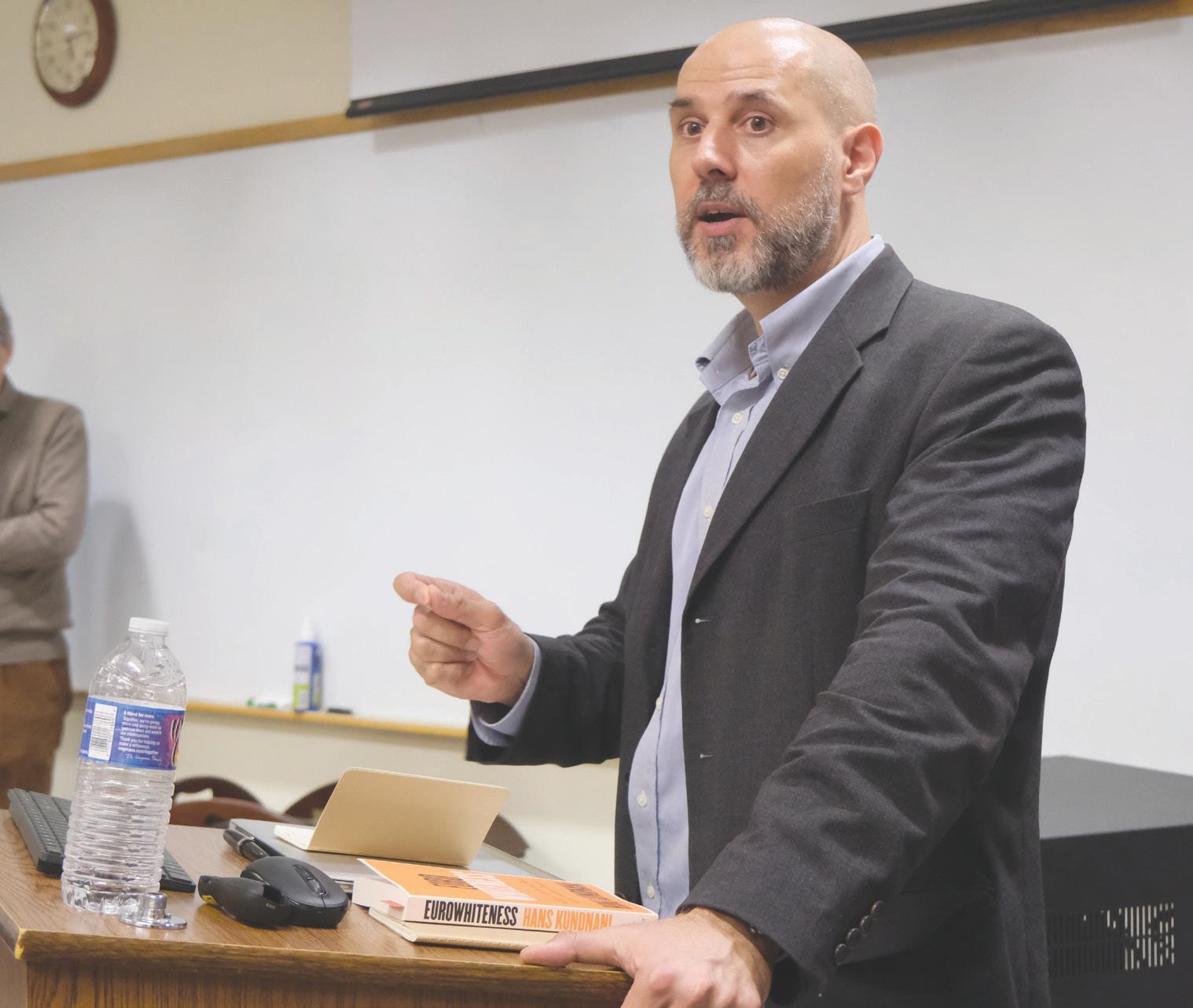
The program has also received criticism from within the university. Kathy Vander Werff, the chair of the Communication Sciences and Disorders department, said the program has had a statement separating itself from facilitated communication for “a number of years.”
In an updated April 2023 statement, the CSD department wrote that it supported the use of “evidence-based treatment approaches for (AAC)” and that, specifically, the program does not advocate for approaches such as FC where “there is ambiguity regarding whether the client or a ‘facilitator’ is the source of a message.”
In an email to The D.O., Vander Werff wrote that the CSD department “strongly opposes” the use of facilitated communication. She also wrote that the CSD program stands by the position of ASHA, which believes FC lacks validity, in that FC “fails to represent the individual’s true communication” and that it “poses significant risks.”
“We are aligned with ASHA’s stance and the ethical obligation to advocate for empirically supported communication interventions that genuinely enhance independence and authentic communication for individuals with disabilities,” Vander Werff wrote.
ASHA highlights the potential harms that can arise from FC, such as hindering or delaying “access to appropriate services and effective forms of intervention, including (AAC).” ASHA’s position also states that FC can result in false allegations of sexual abuse and “other forms of maltreatment.”
One of FC’s most high-profile controversies is what The New York Times Magazine called “The Strange Case of Anna Stubblefield.” Stubblefield was a tenured professor of ethics at Rutgers University and a facilitator for Derrick Johnson, a non-verbal adult with cerebral palsy. The state of New Jersey, according to journalist Daniel Engber, declared that

Johnson had the “mental capacity of a toddler.”
In 2011, despite her role as a facilitator, Stubblefield told Johnson’s family that the two were in love. In 2015, she was found guilty of two counts of first-degree aggravated sexual assault.
Due to an appellate court ruling that Stubblefield did not get a fair trial, her conviction was overturned in 2017. In 2018, a judge ruled that she would not have to go back to prison after she made a deal with prosecutors to plead guilty to third-degree aggravated criminal sexual contact.
Despite research against the use of FC and highprofile abuse allegations, the ICI has continued to promote the practice outside of its workshops. The program’s research statement reads that “despite the diverse types of research in which individuals have successfully demonstrated authorship, controversy over the method persists.”
Travers took issue with the idea that there are “diverse types of research” demonstrating authorship, saying he had not seen any research where a person independently authored what was being attributed to them. In terms of “controversy,” he compared FC to global warming.
“There is no scientific controversy at all about facilitated communication,” he said. “There are individuals who refuse to accept … evidence or have opinions that are diametrically opposed to what the evidence says.”
Travers said that oftentimes people view FC as a “historical lesson” in the dangers of confirmation bias and pseudoscience. But, Travers said, facilitated communication is not something solely found in the past.
“It is not a history lesson,” he said. “This is an ongoing problem. It’s dangerous, it’s harmful and I offer my strongest recommendation to avoid the technique.”
kschouin@syr.edu
dailyorange.com news@dailyorange.com 6 february 29, 2024
page 1 communication on campus
from
olivia fried editorial editor
hans kundnani talks about his new book with students and professors at Syracuse University’s Center for European Studies at the Moynihan Institute. maxine brackbill photo editor see kundnani page 7 scribble
need to be valued negatively or wrapped in stereotypes and stigma. Disability is not viewed as a condition to be cured but rather as a difference to be accepted and accommodated.”
One of the biggest names in disability studies’ prehistory was Burton Blatt, who was named dean of the School of Education in 1976. Though, according to his namesake institute at SU, he’s best remembered for “Christmas in Purgatory,” a “photographic exposé” of the conditions in mental institutions published in 1966.
The book, both in its writing and photos, describes the dormitories people with disabilities had been forced into for decades. In one instance, Blatt described the recreation rooms as having an “overpowering” odor, a byproduct of feces being smeared into cracks in its wooden floors.
“There is a hell on earth, and in America there is a special inferno,” Blatt wrote in the book’s opening. “We now have a deep sorrow, one that will not abate until the American people are aware of — and do something about — the treatment of the severely mentally retarded in our state institutions.”
In its summary of Blatt’s papers, SU’s Special Collections Research Center wrote that the book caught President Lyndon B. Johnson’s interest. Johnson personally called Blatt for additional copies of the book and, according to the SCRC, “Christmas in Purgatory” reportedly influenced Johnson’s then-recently established Committee on Mental Retardation. Today, the group is now known as The President’s Committee for People with Intellectual Disabilities.
Three years after the book was published, Blatt made his way from Boston University to SU, where he was the director of the Division of Special Education and Rehabilitation at SU’s School of Education.. He also founded the Center on Human Policy and solidified his impact through three figures: Taylor, Bob Bogdan and Doug Biklen.
Rachael Zubal-Ruggieri, now an administrative assistant at the Burton Blatt Institute, said she was Taylor’s “left hand” while at SU. ZubalRuggieri said Taylor, Bogdan and Biklen greatly changed the way disability was taught at SU.
“They kind of integrated inclusive teaching into their curriculum at the school,” Zubal-Ruggieri said. “Over time, they radically changed how the program was taught. And this began in the ‘70s with the recruitment of these three men.”
They also changed how disability was studied. Years before the word “ableism” was coined, Bogdan and Biklen published “Handicapism,” which defined the word as a “set of assumptions and practices that
from page 3 grid
Dana Fries, a senior at SUNY ESF, said she is “apprehensively” in favor of the plan, as she worries about how the project will impact Syracuse’s South Side neighborhood.
“(Frank was) saying that there were a couple of different options for the South Side (and) that some things are gonna be a challenge. I’m just worried about the trust of those people, because they have been displaced before,” Fries said.
from page 3 ai
in the classroom. Many schools at SU, such as the College of Engineering and Computer Science and the School of Information Studies, have implemented AI in their classrooms.
The iSchool additionally launched a class on AI titled Information Studies 300: AI and Humanity in the fall 2023.
Lisnyczyj, who teaches and frequently works with non-English speaking students, spoke about the impact AI translators like DeepL — an AI tool that creates incredibly accurate translations — have on education.
from page 6
of empire.” When he speaks in Europe, he said people often try to avoid conversations about race, especially whiteness.
Kundnani has spent the last 15 years or so working at a series of foreign policy think tanks similar to Chatham House, he said. Initially, he thought of himself as “pro-European.” Now, he considers himself a “eurosceptic” — which Oxford Reference defines as a person who is “sceptical of the European Union and European integration” — because he can imagine a “completely” different EU.
“I think, beyond a certain point, if your vision for the EU is so different from the current one that what it would involve doing to make it a reality is unwinding a lot of the existing steps in European integration to then be able to create
promote the differential and unequal treatment of people because of apparent or assumed physical, mental, or behavioral difference.”
“We hope that the handicapism paradigm will enable researchers and practitioners to begin to reassess their assumptions concerning segregated service, differential treatment, the real source of the disability problem, labeling and language patterns, and funding mechanisms tied to labeling,” Bogdan and Biklen wrote.
Like Blatt, both Taylor and Bogdan visited mental health institutions and were appalled by the conditions. Bogdan came to similar conclusions to Blatt, noting their awful sanitation and poor staffto-patient ratios. They weren’t places that were helping people, Bogdan said, they were prisons.
Zubal-Ruggieri said Taylor was similarly affected.
“That just kind of changed his life,” Zubal-Ruggieri said. “‘How can I just study this and not do something about it?’ And that’s kind of what Blatt taught his students. You can’t just go in and study services, you’ve got to work on change.”
In one case, Bogdan said he and fellow activists were working with parents to put pressure on reforming a local state school for people with mental disabilities. According to Bogdan, an administrator heard about their work and called Blatt to put a stop to it.
“Do you know what your people are doing? You shouldn’t be doing that,” he remembers the administrator telling Blatt.
While Bogdan isn’t sure what Blatt said in response, he did say Blatt returned with the complaint. They promptly disregarded it.
Biklen said he first interacted with Blatt after hearing about a lecture he planned to give on human abuse and public policy. The lecture featured photos of the same conditions pictured in “Christmas in Purgatory.” After talking following the lecture, Blatt invited Biklen up to talk in his office.
Soon after, Blatt offered Biklen a research assistantship. The pair, according to Biklen, developed SU’s Center on Human Policy, which was founded in 1971.
Today, Biklen believes he’s largely known for two things: his early work in disability advocacy and facilitated communication, a largely discredited technique attempting to aid non-verbal people with developmental disabilities with communication. In FC, a “facilitator” provides physical support to the “user” so that they can point to what they’d like to type. However, decades of research have shown that it is the facilitator authoring the message, not the user.
Biklen popularized facilitated communication in the U.S. after learning of the technique in Australia in 1989, according to SU’s Inclusion and Communications (ICI). Just four years later, Biklen established the Facilitated Communication Insti-
The open houses were held on both the South Side and North Side of the city, with Tuesday’s open house at Dr. King Elementary School in the South Side neighborhood and Wednesday’s discussion in the north, Walsh said.
“We did intentionally come here on the northern side of the city, because that is an area that has received less attention, I think, over the course of the debate and discussion on I-81,” he said.
Other longtime Syracuse citizens also expressed their concerns with the project, citing how it may impact low-income housing.
Judy Jerome, a retired librarian, SU gradu-
Many students who feel their English isn’t “strong enough” to articulate their ideas rely on AI translators, Lisnyczyj said. She said the resource can be useful to help students gain an understanding of a given text when used in moderation.
“As non-native speakers, obviously, a lot of the text that they have to read is dense, and so they have that extra challenge,” Lisnyczyj said. “I say (to my students), if that is going to help you, you should still read it in English after, because then you’re learning the vocabulary that’s necessary for that topic … but at least you’ll have the understanding.”
After the presentation, the panelists opened the floor for attendees to share their experiences navigating AI in the classroom. Attendee Moira
something new … it becomes a bit perverse to say ‘No, but I’m pro-European too,’” Kundnani said.
Kundnani said his former boss at the European Council on Foreign Relations wrote a book called “Why Europe Will Run the 21st Century.” There are, at least, two problematic things about this potential form of global governance, he said.
“It leads, it seems to me, to a revival of the idea of a European civilizing mission — mission civilisatrice,” Kundnani said. “It’s one of the long continuities in this long story of European identity … this idea that we are civilizing the world.”
Anthony Ornelaz, a student in SU’s master’s program for creative writing and a Tillman Scholar, attended the event for his European Integration class taught by Glyn Morgan, the director of the Center for European Studies and associate professor in the political science
tute, which exists today as ICI under SU’s School of Education.
While today the university mostly refers to the practice as “typing to communicate,” FC is still promoted through ICI both through workshops and readily available resources.
Blatt died around a decade before the start of the disability studies program, but he laid foundational research for the field and influenced three of the people who would shape the program. Bogdan is still attached to the university as a professor emeritus in the Maxwell School of Citizenship and Public Affairs. Biklen, who now lives in Australia, was the dean of the School of Education from 2006-14.
Taylor died on Nov. 8, 2014 at his home in South Onondaga. Not only did he help establish the disability studies program at SU, but he was also the Center for Human Policy’s director from 1983 to 2014. Zubal-Ruggieri said she and a collection of former students of Taylor’s are in the “draft stage” of writing a book on Taylor’s life and work.
Bogdan, Biklen and Taylor were all important figures in their respective aspects of disability studies and, for some who pursued disability studies at SU, part of the reason they came to the university.
Beth Ferri first joined SU in 2002, but said she identified as a disability studies scholar long before that. While at Teachers College at Columbia University, her floor department chair said the SU role would be perfect for Ferri, as if it was written for her. Ferri wasn’t in the job market, but she gave the position a look anyway.
“I knew the tradition at SU,” Ferri said. “I knew people like Steve Taylor, Doug Biklen, Bob Bogdan. These were sort of intellectual heroes of mine so I quickly decided, ‘Yes, I should apply.’”
Over the last decade, Christine Ashby, the director of ICI, said the field of disability studies has moved toward a better understanding of intersectionality and how other identities, such as race and gender, alter people’s lived experiences with disability. Over its half-century existence, most in the field agree that disability studies has been overwhelmingly white.
“And so thinking about recognizing that, how do we think about disabled students of color? How do we think about students who are multiple marginalized, and adults that are multiple marginalized?” Ashby said. “That’s been a big shift in the field.”
While the collective shift may be new, its presence at SU is not.
One of the earliest critiques of the field relating to race came from Chris Bell, who came to SU from Towson University after Taylor met him in 2006. That same year, he published “Introducing White Disability Studies: A Modest Proposal,”
ate and resident of the University Hill neighborhood, described herself as an “advocate” for people who reside in the neighborhoods that I-81 originally displaced.
“My biggest concern is that they will not make adequate housing for the people that need housing in that area,” she said. “Years ago, when I first heard it proposed, I thought ‘What a dumb idea.’ I (then) read, I educated myself and the more I read about it, the more I saw what was being done in other cities. I thought — ‘I’m an advocate.’”
The vision plan is still in the draft stage,
McDermott, an associate teaching professor of mathematics, said she agreed with Hallas that students tend to use AI when they have procrastinated on their work.
McDermott said addressing and preventing students’ procrastination is crucial in preventing AI abuse in a classroom.
“I remind them every week (to) make sure that (they) take a look at the assignments when they come out,” McDermott said.
Sebastian Tideman-Frappart, another attendee and an assistant professor of accounting at SU’s Martin J. Whitman School of Management, said he holds a different perspective on AI tools in education
department.
“I think it’s an important topic given the fact that Europe and America’s connection is vastly, dynamically changing,” Ornelaz said.
Kundnani closed his book with a chapter on Britain. His father is Indian and his mother is Dutch, and they both came to Britain in the 1960s, he said. It was much easier for his father to come to Britain from India than it was for his mother to come from the Netherlands, he said.
His mother, a woman with blonde hair and blue eyes, felt like an outsider in British society. This has to do with a “very particular history” of the British Empire, wherein Commonwealth citizens — those from Britain’s former colonies, including Caribbean countries and India — were considered British citizens.
“They didn’t come to Britain as immigrants,” he said. “We’ve retrospectively reimagined them as immigrants, but actually there were
one part a sarcastic reflection on the field’s history and one part a scathing critique of its ongoing failure to properly engage with race. “White Disability Studies,” according to Bell, was a more accurate name for the field at the time.
Reviewing for Disability Studies Quarterly in 2012, Adam Newman wrote that Bell himself brought the intersection of race and disability into “widespread visibility” with the essay. Bell’s contributions to the field stand out even more because he was around 30 when it was published.
Bell, who was HIV-positive, died in 2009, three years after his field-disrupting piece. When he died, he was an ARRT fellow at the Center for Human Policy, Law and Disability Studies at SU.
“Chris is committed to social justice,” Taylor told The Daily Orange in 2008, a year before Bell’s death. “He recognizes the parallels between what people with disabilities have faced in society and the discrimination and marginalization members of other groups have experienced based on race, ethnicity, gender, and sexuality.”
The same year Bell took on the field of disability studies, Ferri released her first book, “Reading Resistance: Discourses of Exclusion in Desegregation and Inclusion Debates,” which she wrote with now-CUNY Professor Emeritus David Connor.
Bogdan and Biklen were attuned to the changes in the field of study they helped create. In a 2013 addendum to “Handicapism,” they wrote that, in retrospect, there were gaps in the piece, namely a lack of focus on the voice of people with disabilities, the political economy of disability services and the concept of double discrimination.
“We should have emphasized the especially intense, even magnified form of handicapism experienced by people who were the targets of racism,” the two wrote.
In 2024, the disability studies program takes two forms — a minor for undergraduates and a certificate of advanced study for graduate students. Looking ahead, School of Education Dean Kelly Chandler-Olcott said the school wants to attract more students to both the minor and CAS. At the same time, she said the school is interested in researching what a disability studies major would look like.
“We are really trying to think about sort of what disability studies 2.0 or even 3.0 in this contemporary moment,” Chandler-Olcott said, “and I think we’re much more aware of all of the ways, both positively and negatively, that disability sort of intersects with and amplifies other identities.”
@Kyle_Chouinard
Frank reiterated throughout the open house. Once the plan is finalized after receiving feedback from Syracuse residents, the Dover, Kohl & Partners team will submit a strategic action plan to the city — a “shopping list” of every idea, Frank said. The city will then have a detailed proposal of reviewed feedback for future construction projects.
“Our best job right now is to get as close as we can to what everyone can agree on is the future of what they want Syracuse to be when they grow up,” Frank said.
ajsturm@syr.edu
than the panelists.
Tideman-Frappart said it is important to remember the potential benefits of AI, such as how it can accelerate basic tasks so students can focus more on the details. Because AI is going to be a prominent tool in many students’ future careers, he said he would encourage faculty to implement assignments that cultivate responsible AI usage.
“AI is primarily a tool, right? Like if I think about the business students, that’s huge … they’ll be exposed to AI and things are changing,” TidemanFrappart said. “They’ll have those tools available. So, for us as instructors, it’s our task to teach them how to use them.”
bnelson@syr.edu
citizens moving from one part of the Commonwealth to another.”
The balance between the Commonwealth and Britain’s former colonies has “completely reversed” in the course of Kundnani’s lifetime. It has become much easier for people from Europe to live in Britain, and much more difficult for people from Britain’s former colonies, he said.
“Is there not an opportunity for Britain and Brexit to reinvent its identity in a less Eurocentric way? To go back to this hiwstory and deepen our relationship with our former colonies — perhaps as part of a project of reparations — to deepen our engagement with our own colonial past?” Kundnani asked. “Rather than being an expression of white anger, it’s sort of almost the opposite. There’s a certain kind of, I think, anti-racist potential.” arflemin@syr.edu
dailyorange.com news@dailyorange.com february 29, 2024 7
kundnani
kschouin@syr.edu
from page 1 disability studies

dailyorange.com 8 february 29, 2024

From orange slices to mascots, the SU community requests a variety of tattoos every year to commemorate their college experiences
By Kelly Matlock culture editor
Syracuse University alumna Margo Moran’s latest tattoo is representative of the relationships and memories she made at college. The ink on her right arm isn’t an orange or another typical SU symbol. It’s a cowbell, representative of a dog she adopted with her roommates.
“God forbid if I’d gone somewhere else (for college), I never would have met these people and I wouldn’t be me,” Moran said. “All of the best parts of my life wouldn’t be what they are without the people I met at Syracuse, so this tattoo absolutely represents that for me.”
Whether meaningful or lighthearted, many SU students each year get a tattoo related to the university. Syracuse-themed tattoos spike during graduation season, said Halo Tattoo artist Mike Delaney, but students and alumni request SU tattoos year-round.
Sometimes, Syracuse residents ask for tattoos of the campus or professors ask for tattoos of their subject matter. Delaney often does plants for SUNY ESF professors or outlines of the JMA Wireless Dome for Syracuse residents.
On one occasion, a group of students requested the same Otto the Orange tattoo. Delaney learned the members of the group had all been Otto mascots during their time at SU.
The most popular SU-related tattoos Delaney does are university logos and oranges — both Otto or otherwise. He said many seniors get SU tattoos as a sort of “road map,” a way to mark the occasion of the next steps in their journeys.
Moran said SU alumni are more passionate about their alma mater than many other alumni.
“Maybe everyone feels that way about their school, but I can’t imagine any other place being as special as Syracuse,” Moran said.
Moran, along with friends Mary Shalaby and Brita Evans, got her tattoo last year to commemorate adopting Cowbell. They found the pitbull wandering around Thornden Park before naming and adopting him.
“Much of what was so special about that dog was that he really changed the nature of our relationship,” Moran said. “It made the three of us bonded for life so this tattoo was a way of kind of signifying — especially since (Evans) and I were graduating — that permanent bond between us.”
The SU community embraced Cowbell, Moran said. She described him as an “overnight sensation” and a “campus celebrity.” When he was diagnosed with cancer, the community helped fundraise for his medical expenses.
“(Students were) donating a lot of money …to help us get him surgery. People cared so much about this dog,” Moran said. “I don’t know if that would happen at another school. It felt very specific to Syracuse and what makes us special.”
For Moran, her tattoos are simultaneously silly and meaningful. She has a tattoo of a pigeon that represents her connection with her mom, but is a “goofy” design as well.
Sophomore Jo Konjufca also sees tattoos as something both sentimental and silly. She has five tattoos, choosing designs related to memories she finds “monumental.”
When Konjufca met Matthew Gray Gubler, an actor in “Criminal Minds,” she explained to him that SU’s mascot is an orange. She asked him to draw an orange tattoo, so he drew a circle around the word “orange.” Konjufca got his drawing tattooed on her ankle shortly after.
“I wanted to get (that moment) tattooed as a memory,” Konjufca said. “It’s like two of my interests in one … It’s also just fun to talk about. If someone were to ask, ‘Oh, what’s that,’ it’s fun to go back in that memory lane.”
Konjufca visited her family attending SU while she was in high school, and “fell in love” with the university after visiting family who also attended SU. She said the college is more important to her because she has wanted to go since then.
Syracuse University junior Janna Van Vranken got an orange tattooed on her ankle during her freshman year. The tattoo has many meanings, both goofy and serious; she is a Syracuse native and worked on ‘Cuse Tonight at CitrusTV, but, most of all, the tattoo is “a good bit.”
Van Vranken’s executive producer announced she was getting a tattoo for the show in 2021 and asked if anyone wanted to join. She thought “Why not?” and considers the orange on her ankle as a “little piece of home that will follow (her).”
“I was born and raised in Syracuse, I’ve lived here my entire life. It’s very much my home, and I think home is a special thing to me,” Van Vranken said. “Then, I also go to school here, so it’s like, ‘Baby bleeds orange through and through.’”
kamatloc@syr.edu
Moppn’s comedy special at Wescott 10 years in the making
By Griffin Uribe Brown assistant news editor
When he was 13 years old, Jordan Bullock — who now goes by the stage name Moppn — had an English teacher who would walk around holding a jar filled with prompts which students called the “Jar of Death.” To get her students comfortable with public speaking, she had them choose a random prompt and answer it at the front of the class.
One day, the teacher and her dreaded jar landed on Moppn. “If you could be any mythological creature, which would you choose?” the prompt read. When he went up to the front of the class to deliver his three-minute answer, Moppn did not talk about mythological creatures. Instead, he told jokes to the 30 kids in front of him.
Nearly a decade later, Moppn is a Syracuse University senior studying television, radio and film at the Newhouse School of Public Communications. On Friday, he will perform his taped hour-long debut comedy special and senior TRF capstone project, “Ashwagandha,” at Westcott Theater. SU student comedians Julia DiCesare, Mary Shalaby and Ronan Mansfield will open for him.
As a comedian, Moppn started participating in talent shows and writing showcases in middle school. Then he did stand-up at clubs at 16 years old until he entered the comedy scene at SU. At the university, his comedy has taken him from the sets of Live From Studio B! and the stages of University Union to Los Angeles.
The TRF capstone is “a challenge” for TRF seniors to produce a project for over a semester, TRF chair Michael Schoonmaker wrote in a statement to The Daily Orange. Moppn’s efforts to produce and market his show have been ongoing since September, he said.
“Ashwagandha” is a plant used by some as an adaptogen, a supplement to relax and destress, Moppn said. When Moppn is on stage, he hopes to “escape from all the stress and anxiety” with his audience.
Moppn’s dream to produce a comedy special dates back to his Jar of Death-fueled comedy days. As a young comic, he identified with the Wanda Sykes and Dave Chappelle specials he watched.
“They talk the way I talk, they think the way I think. I got to do
one of those — I got to do a special,” Moppn remembers thinking at a young age. “I’ve been dreaming for almost 10 years of what (my special) would look like.”
DiCesare is a fellow TRF senior involved in American High Shorts based out of Liverpool. Before both she and Moppn worked on Live From Studio B!, they were freshman-year neighbors in the Brewster, Boland and Brockway Complex, where she first learned of his dream to host a special.
“I remember (Moppn) telling me — and we were 18 — ‘I want to be a Steve Harvey-type, hosting shows and doing stand up,’” she said. “I thought that was so cool, and I hadn’t started doing that yet.”
Although Moppn initially wanted to write an original set for his show, he
found that much of his best material already existed. Through a long cycle of writing and cutting, Moppn weaved together his hits and new material to create “Ashwagandha.”
“I’ve had to cut, and cut and cut because (the set) is almost my whole life story,” Moppn said. “If I was putting out mixtapes before, this is my first album.”
Moppn’s set would not exist without the progression he’s experienced as a comedian and a person in his time at SU, he said. By performing in the Syracuse comedy scene and in Los Angeles during his time in the Newhouse LA program, Moppn overcame doubts that his comedy is regional or specific to one age group.
Doing stand-up on different stages acted as “stepping stones” toward
see comedy page 10
CULTURE dailyorange.com culture@dailyorange.com february 29, 2024 9
from the studio
Kiley Reid’s ‘Come & Get It’ explores the college experience
By Victoria Lafarge contributing writer
After debuting her award-winning novel, “Such a Fun Age,” Kiley Reid delivered once again with her sophomore novel “Come and Get It.” Named “one of 2024’s hottest reads” by Fearne Cotton’s Happy Place Book Club, and a pick for the Good Morning America Book Club, the novel is a notable start to 2024’s releases.
“Come and Get It” follows the story of Millie, a resident advisor eager to graduate college, coming together with a visiting professor Agatha to figure out their internal struggles through a unique endeavor to fulfill academic and financial desires. Millie struggles financially, faces hurdles while making ends meet and deals with the reality of caring for her sick mother.
“Come and Get It” is a coming-of-age novel and cultural commentary. With specific characterization, relatable themes and a calculated, meticulous tone, Reid creates the perfect picture of each character and moment. We see this through her creation of dynamics between the characters, beautifully written descriptions of pivotal story conflicts, and attention to detail in her storyline.
Reid’s story can resonate with college students who use their mental and emotional strength to continue their education despite immense pressure. The author tackles the issues of uncertainty, loneliness and vulnerability on college campuses through Millie’s experiences with academic pressure and the realities of the job field.
Reid’s conversation about loneliness and socialization in college is further articulated through Kennedy, a transfer student and Millie’s resident. Kennedy’s character speaks to the many aspects of college that are rooted in rejection.
Reid writes, “...even if it was happening in her dorm, just an elevator ride away, Kennedy never felt like she had enough time. And she couldn’t tell
what would be worse, showing up to see that she was one of two attendees, or arriving to a bigger group of acquainted people.”
In this quote, Reid characterizes Kennedy as antisocial, a build up to her unfortunate experience at her past college. Her past comes to the forefront with her struggles of being at a new school and alone.
The characterization of each character, Agatha, Kennedy and Millie, offers a different portrayal of the college experience, as well as the devilish desires to reach one’s goals. They’re all problematic in some way, making a rich story.
Kennedy feeds into Agatha’s investigation and questions of the lengths to which loneliness can go for a person. Agatha, the struggling, single, queer visiting professor, takes advantage of Millie and her residents to further her own career, creating a hypocritical mess.
Through describing Millie juggling a job, academics, drama-filled floormates and discovering what’s important in life, Reid encapsulates the endless chaos of college. A large part of the college experience is work and play, which Reid executes through Millie’s dynamic with her residents and Agatha.
Millie walks a thin line with boundaries in her relationship with Agatha and her residents, getting her in trouble and teaching her how to run the risk of life. This risk gives us an anxiously exciting read, and plays with the pressure and responsibilities of college life.
Although “Come and Get It” has lighter themes than Reid’s first novel “Such a Fun Age,” its cultural commentary remains important. With its depiction of college, the novel develops themes like loneliness and self-growth.
“Come and Get It” engages with the realistic aspects of college, offering a thrillingly juicy expression of a wonky college experience.
vglafarg@syr.edu

How to survive sports games when you couldn’t care less
By Sarah Wells humor columnist
There’s nothing like basketball season at Syracuse University. The thrill. The adrenaline. The players. The ball. The net. The court. The referee. The scoreboard. The cheerleaders. The person in the Otto the Orange costume getting heatstroke.
Personally, I like basketball. I think it’s a lot of fun to watch people fight over an orange sphere, like dogs going after a steak. However, it doesn’t mean the initial joy of being in the JMA Wireless Dome with a bunch of screaming fans won’t get old after a while. I can only hear fraternity boys and freshmen chant “LET’S GO ORANGE *clap clap clap-clap-clap*” so many times.
The home games just ended for this season, but I think we need a game plan for next year. So, for those of you who tire easily by watching sports games, or perhaps those whose friends drag you to the Dome in the name of “College ExperienceTM,” I have the perfect boredom busters to keep you busy after the game has lost your interest.
Are you crafty and creative? Then I most certainly recommend bringing some sort of yarn craft to the game. My medium of choice is crochet. Sure, they might not let you bring needles in the Dome and it can be hard to count your stitches over
from page 9
comedy
“Ashwagandha,” Moppn said. The Playground, a student-run comedy club run out of a house on Comstock Avenue, was one of these stages. Moppn and his three openers are all Playground regulars — DiCesare and Shalaby are co-managers.
“Being on the (Westcott Theater) stage is so different than standing up in front of a group of kids sitting on the ground or in chairs who are basically as tall as you are (at the Playground),” said Shalaby, a senior majoring in English.
Shalaby, who has known Moppn since they were both sophomores, said the two have crossed paths at various shows since they met. When she met Moppn, she was in “awe of his ability.” The two have supported each other ever since.
Mansfield, a sophomore majoring in creative writing, said Moppn pitched his special to him sometime last year at a show they were performing at. He said he is excited to perform on the Westcott Theater stage — his “biggest” show yet since its around 700-person seating surpasses the Playground’s 40-person capacity.
“These are some of the best comedians on campus,” Moppn said. “(‘Ashwagandha’) is

the sound of the cheering, but if you ask the people around you to quiet down a bit, they’re usually too confused to decline.
The same goes for bringing a good book! Want to be the mysterious one in the stands? Then bring your favorite copy of any of your favorite novels! Personally, I prefer the subtle yet cheeky prose of Jane Austen to accompany me to any
sports outing. You may ask me, “Sarah. Isn’t bringing a book to a basketball game kind of pretentious?” To which I’d have to answer, “Yes, but it’s less embarrassing if you own it with pride (and prejudice).”
Another favorite pastime of mine?
Hypothesizing what songs the players listen to in the locker room to get hyped up. For example, I
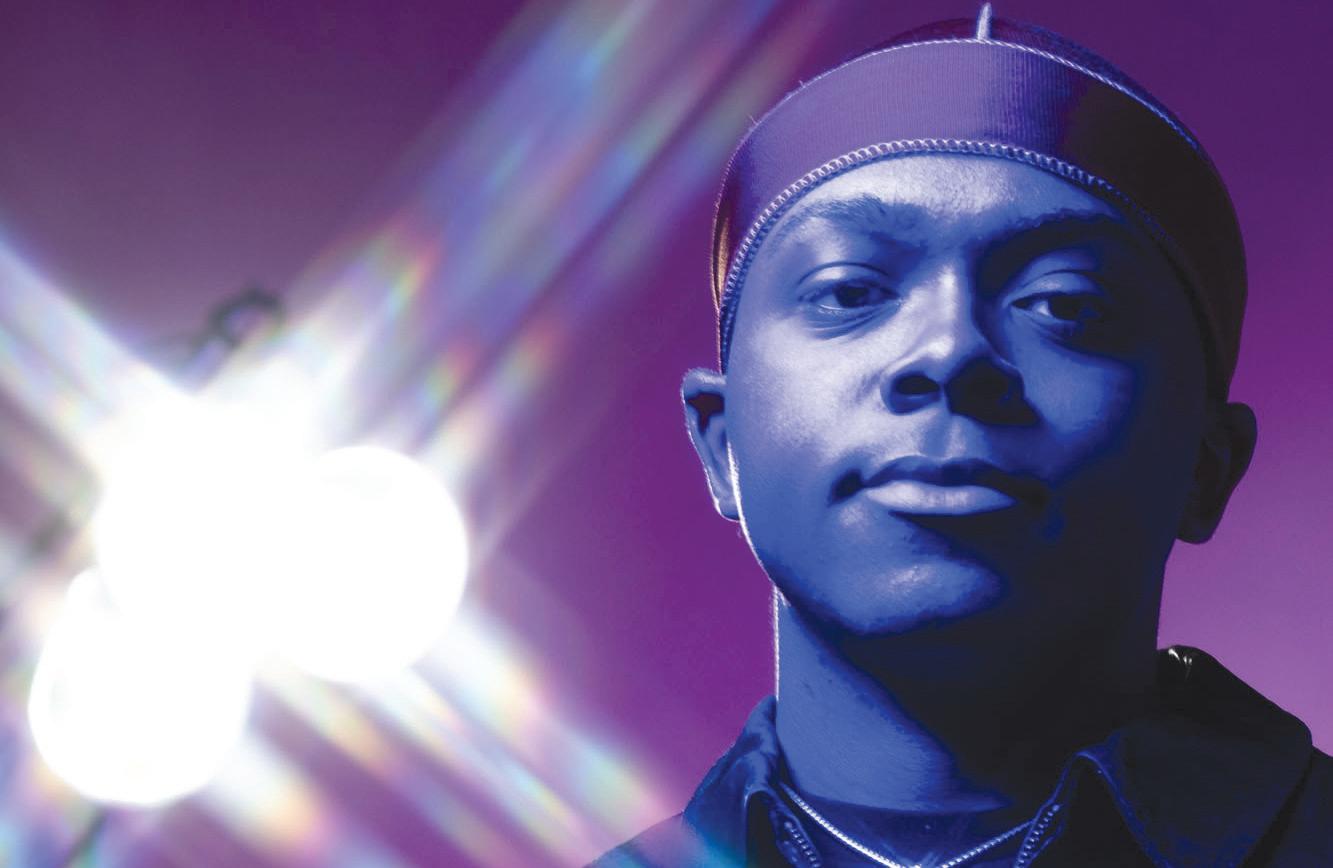
giving them all a chance to shine and also bring people to the show.”
Though the last few weeks have been filled
with the challenges of logistics, production and promotion, Moppn knows “jokes are what matter.” Ultimately, he’s embracing the
think Judah Mintz’s would be “C’Mon” by Kesha. The man just seems like he’d enjoy some of the upbeat stylings of Kesha Rose Sebert. Plus, it’s very entertaining to imagine him dancing along to it in the locker room.
If you run out of players, however, you cannot forget my tried and true: eavesdropping. Oh no, the couple sitting in the row in front of you is fighting? Depending on how much one of them messed up, this could provide a whole game’s worth of entertainment. What!? Did he get her regular Pepsi instead of Diet? What a dirty scoundrel.
One other classic game I like to play is “Where’s Otto?” The best part of Otto is that they NEVER GIVE IT A REST. It’s like they get fired if their heart rate goes below 160 beats per minute. You look to your right, they’re at the peak of the cheerleaders’ pyramid. You look to the left, they’re doing backflips off of Adrian Autry’s shoulders. One thing I promise you, playing “Where’s Otto?” will never fail to bring entertainment.
Let’s be honest. Not all of us have the attention span to pay attention to a whole game of basketball. Or soccer. Or football. Especially football, what on earth is going on with the numbers on the field? That’s why this foolproof guide is here for you year-round.
sswells@syr.edu
opportunity to put out a special directed, edited and performed by him.
“People say all the time, ‘Oh, this is a dream come true.’ But this is like all of my dreams coming true right now,” Moppn said.
gbrown19@syr.edu
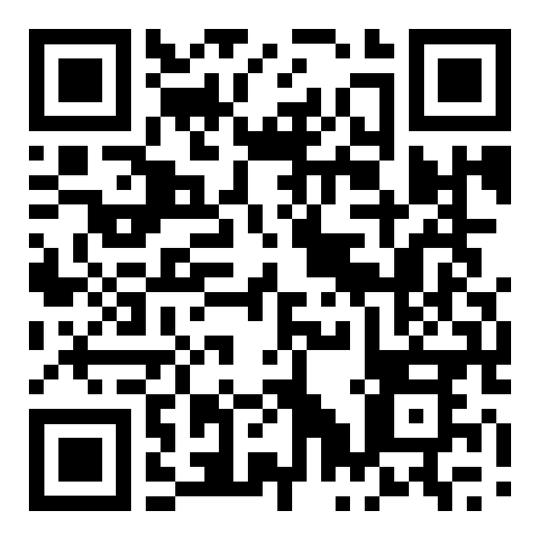
dailyorange.com news@dailyorange.com 10 february 29, 2024 book review
“Come and Get It” explores college student struggles, like loneliness and self growth. Its characters — Millie, Agatha and Kennedy — are dynamic. nora benko illustration editor
humor column
Cuddle up in the stands with a book if you’re not a sports fan. Our humor columnist’s book of choice is anything by Jane Austen. flynn ledoux contributing illustrator
Syracuse University and comedian Moppn is performing Friday at Westcott Theater. Moppn is preparing for his first comedy special titled “Ashwagandha.” malcolm taylor staff photographer
Since Oct. 7, the Israel Defense Force has ‘badly damaged or destroyed’ at least 14 libraries
 SOFIA AGUILAR
SOFIA AGUILAR
POP CULTURE PRINCESS
For months now, watching Israel’s relentless genocidal acts against Palestine has redefined what I thought I knew about cruelty and violence – their blocking of humanitarian aid, arresting and brutally torturing civilian prisoners often without cause, allegedly abusing and raping girls and women. But, one aspect of their campaign that has largely been left out of mainstream discourse is Israel’s recent destruction of Palestine’s libraries, archives and universities since Oct. 9, known commonly as “scholasticide.”
By damaging, looting or completely destroying 14 libraries, publishing houses, bookstores and archival buildings, as well as 378 schools, including 12 universities as of Feb. 8, Israel is destroying important sites of Palestine’s culture, heritage, history and knowledge and, subsequently, any physical record of their existence within Palestinian borders.
As a Library and Information Science student, these attacks anger me beyond description.
raids to bury them under the rubble of their own homes.
On top of everything else, what books are left are being burned by Palestinian children out of desperation to stay warm in their tents, forcing them to unwillingly participate in the destruction of their own heritage. It also furthers Israel’s systematic attack on any semblance of knowledge in a region that, prior to the current and ongoing genocide, boasted a national literacy rate of 97.7%.
“We are now sitting in the school library we were displaced to, and instead of reading books, we burned them to light a fire for ourselves,” Palestinian student Rahaf Hamad told Al Jazeera. In other cases, it’s the only worldly possessions survivors have left. It’s what happened to the family of Palestinian poet and Syracuse alum Mosab Abu Toha, who were “looking for food under the rubble of my bombed house. All they could find were books.”
But I also mourn the loss of irreplaceable collections of rare books, valuable cultural artifacts and hundreds of years worth of historical records.
Sofia Aguilar columnist
Growing up, libraries were my source of solace and comfort, a place I visited with my family on the weekends as soon as I could sit and listen to a story. It’s where I first found a love of reading, learned about important moments in history and came to better understand my identity and place in the world.
Now halfway through my first semester of graduate school, I have learned that there are plenty of reasons why libraries are imperfect, whether it be funding issues, a lack of staff diversity or material censorship from within the institution itself. But, that hasn’t changed my conviction in the idea that libraries can be revolutionary and lifesaving; they are in fact heritage sites of collective knowledge that represent the identity of a people and nation.
To me, it’s bad enough that Israel has destroyed Palestine’s ancient physical buildings, which represented the state’s heritage through their architecture. But I also mourn the loss of irreplaceable collections of rare books, valuable cultural artifacts and hundreds of years worth of historical records. I mourn the killings of those who were sheltering in these spaces for safety, like in the case of the Diana Tamari Sabbagh Library in November. I mourn the thousands of teachers, students, librarians and scholars who were reportedly targeted in deliberate IDF air
Unfortunately, the truth is that this has all been happening long before Oct. 7. During the 1948 Nakba, the Israeli military looted and destroyed Palestinian archives and libraries.Today, Israel is erasing Palestinian culture and history, and even more so, preventing Palestinians from documenting evidence of the violence being committed against them. After all, without records, it’s difficult to verify facts or truth.
It becomes easy to deny an entire people of their humanity, dignity and memories, and create new narratives that mythicize them or leave them out altogether from history.
This attack on intellectualism has been happening all over the world throughout history and into today, including in the U.S. Albeit, it’s to a lesser extent, but nonetheless we now live in a country where book bans continue to be on the rise, where the state of Virginia even passed a law making it possible to prosecute and imprison librarians who have restricted materials in their buildings.
If I want to work as a librarian, I will have to anticipate pushback and uphill battles if I want to include materials, say, by Palestinian authors or host Palestinian-centered events and programming. But, I already know that this is not a job without risks, even at the expense of my own life. I don’t even have to imagine a world with limited intellectual freedom – we’re living in it now.
But, it’s important to remember that Israel’s acts of genocide have not been met without resistance. Within Gaza, teachers who have survived IDF assaults are leading classes for children in refugee camps. Zachary Foster, a professor of Palestinian history at Princeton University, has been at work since 2020 creating Palestine Nexus, a comprehensive digital archive of Palestinian maps, newspapers, docu -

ments, diaries and other records from as far back as 1590.
Libraries around the country are currently compiling book lists featuring Palestinian authors of fiction, nonfiction and poetry like “Mother of Strangers” by Suad Amiry, “A Curious Land” by Susan Muaddi Darraj or “Things You May Find Hidden in My Ear” by Mosab Abu Toha.
Even in the face of so much cultural destruction, it keeps me going to witness so
fernanda kligerman design editor
much perseverance, to realize that loss is not without hope, without fight. For my part, I will never stop protecting Palestinians’ right to hold onto their own knowledge, to their intellect, to their history and to their lives.
Sofia Aguilar is a first-year grad student in the Library and Information Science program. Her column appears weekly. She can be reached at saguilar07@syr.edu.
february 29, 2024 11 OPINION dailyorange.com opinion@dailyorange.com Irreplaceable loss News Editor Kendall Luther Editorial Editor Olivia Fried Culture Editor Kelly Matlock Sports Editor Cooper Andrews Presentation Director Bridget Overby Digital Design Director Cindy Zhang Photo Editor Cassandra Roshu Photo Editor Maxine Brackbill Illustration Editor Nora Benko Asst. News Editor Julia Boehning Asst. News Editor Ahna Fleming Asst. News Editor Claire Samstag Asst. Editorial Editor Grace “Gray” Reed Asst. Editorial Editor Kaia Wirth Asst. Culture Editor Rosina Boehm Asst. Culture Editor Savannah Stewart Asst. Sports Editor Aiden Stepansky Asst. Sports Editor Justin Girshon Asst. Sports Editor Zak Wolf Asst. Photo Editor Lars Jendruschewitz Asst. Photo Editor Joe Zhao Design Editor Lucía Santoro-Vélez Design Editor Leah Cohn Design Editor Miranda Fournier Design Editor Fernanda Kligerman Digital Design Editor Cole Ross Asst. Digital Edi tor Faith Bolduc Asst. Digital Editor Olivia Boyer Asst. Digital Edi tor Sydney Brockington Asst. Digital Editor Griffin Uribe Brown Asst. Digital Editor Nick Jepson Asst. Digital Editor Timmy Wilcox Asst. Copy Editor Varsha Bhargava Asst. Copy Editor Roxanne Boychuk Asst. Copy Editor Matthew Gray Asst. Copy Editor Ava Lombardi Asst. Copy Edi tor Samantha Olander I.T. Manager Davis Hood Business Manager Kevin Ross Advertising Manager Christopher Ern Business Asst. Tim Bennett Circulation Manager John Frega Student Delivery Agent Hailey Hoang Fundraising Manager Joanne Stewart Anish Vasudevan EDITOR-IN-CHIEF Kyle Chouinard MANAGING EDITOR Stefanie Mitchell DIGITAL MANAGING EDITOR
Western media prioritizes pro-Israel bias over ethical, accurate coverage
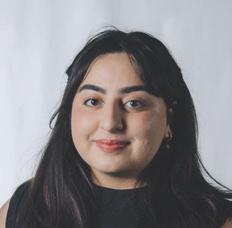 EMANE HAQUE FEMSPLAINED.
EMANE HAQUE FEMSPLAINED.
When I began studying at the Newhouse School of Public Communications, I was bright-eyed with pen and paper in hand, hoping to master the craft of journalism. I was ready to break into the media industry post-grad and be a part of the fourth estate. Now, weeks away from graduating, it’s hard for me to not be disillusioned with the state of journalism.
These past few months, having witnessed the West’s reporting on Gaza, I have seen headlines, reports, op-eds and political cartoons so wildly racist, Islamophobic, anti-Arab and anti-Palestinian that I have begun to question how I could be part of an industry that I once viewed as noble.
From parroting unconfirmed claims of Israeli and American officials; lack of factchecking and sourcing; fear-mongering and sensationalizing Muslim, Arab and brown people as innately violent; not allowing anti-war or diverse viewpoints; and using and creating racist rhetoric, the media has not just passively overseen the Israeli and American government’s destruction in Palestine, but actively given its stamp of approval for genocide.
Western editorial and newsroom coverage have proven to “whitewash Israel’s crimes against the Palestinians, obscure the great power asymmetry between the parties, and exempt Israel from any responsibility for its actions,” according to The New Arab.
Not even beloved liberal-leaning papers which progressives consider to be the gold standard of journalism are innocent. An Intercept analysis looked into coverage from The New York Times, Washington Post, and Los Angeles Times and found that “for every two Palestinian deaths, Palestinians are mentioned once. For every Israeli death, Israelis are mentioned eight times — or a rate 16 times more per death that of Palestinians.”
A few egregious examples of Western media bias which should forever mar the reputation of these outlets include: a Washington Post headline which called the murder of four Palestinian babies “lives found ended” rather than plainly stating they were killed at the order of the Israeli Defense Forces; a New York
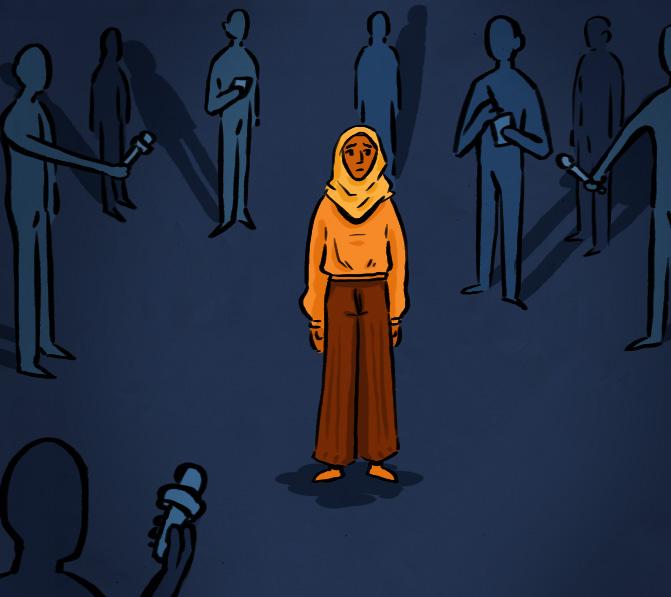
Times report calling a bombed refugee camp a “densely populated neighborhood”; and an ABC News headline calling the 12,300 children killed by Israeli bombardment “Palestinian minors.”
“At the very least people are asking for the media to be specific and accurate,” said Newhouse Professor Nausheen Husain, whose research focuses on news coverage of the “War on Terror” after 9/11. “It’s almost like we are asking for objectivity, which is an insane thing because objectivity is such a flawed concept. But in this situation, objectivity would be a huge step up in our case. We are not an objective media. We tend to dehumanize people and blatantly favor occupation and violence.”
Instead of acting independently to obtain information, newsrooms are choosing to open stories up to Israeli censorship and bias. All of CNN’s Gaza coverage is monitored and approved by the IDF before publication. CNN,
ABC and NBC journalists embed with the IDF, making them “susceptible to legitimizing the military’s view of the conflict,” according to The New Republic.
Across major American media outlets, serious ethical violations are being committed. Recently, the NYT employed a former Israeli military intelligence agent who was found to have liked a tweet calling for Israel to “turn the [Gaza Strip] into a slaughterhouse.” Anat Schwartz, despite having no journalistic experience, was the principal reporter in a controversial NYT piece which has been criticized for weaponizing rape in service of Israeli propaganda. While the NYT has attempted to distance themselves from the writer, they must not be excused for their malpractice.
“The intention isn’t really that important if the impact of that reporting is that a lot of brown people in the Middle East are bombed and killed, then that’s an impact we need to
think about as newsrooms,” Husain said.
I worry how I may navigate working for corporations and with colleagues who have contributed to harming my communities. I wonder what the standard practices will be regarding the Middle East and Muslims, who deserve to be covered with fairness, accuracy and respect but rarely are. I also know, realistically, that I cannot alone fight back against bias and damaging coverage in an industry that suppresses media workers whose viewpoints stray from the media’s anti-Arab and antiMuslim prejudice.
What makes me hopeful during these bleak times are the journalists, like the Writers Against the War on Gaza, who collectively “stand in opposition to the silencing of dissent and to racist and revisionist media cycles.”
They reject justifying Israel’s horrible acts of war as an appropriate response to the October 7 attack; they refuse to shape the mainstream consensus against Palestinainans and manufacture consent for their annihilation. These should be the responsibilities of journalists across the board, not rare instances from a few.
I truly admire the Palestinian media workers on the ground, like Motaz Aziza, Bisan Owda and Waed al Dahdouh. They’ve done the heavy lifting in showcasing the reality of Israel’s occupation, war crimes and indiscriminate killing of civilians. But in our commemoration of their efforts, we must mourn the cost of their tenacity. In modern history, this has been the most deadly period for journalists, with a confirmed 89 Palestinian media workers killed by Israel.
Yet, I also fear for the journalists who remain in Gaza. They are targeted not only because they are Palestinian but because, unlike the Western media, they have remained unwavering in practicing the basic tenets of journalism.
Instead of waiting for American legacy media outlets to pivot towards fair coverage, our focus should be amplifying the work of Palestinians who bear witness to the horrors committed by Israel against their people. As journalists, we must stand in solidarity with our fellow colleagues and call for Israel’s killing of Palestinian journalists, a crime against humanity, to end.
Emane Haque is a senior Magazine Journalism major. Her Column appears bi-weekly. She can be reached at eohaque@syr.edu
In talking about ecology, art can be more effective medium than statistics, numbers
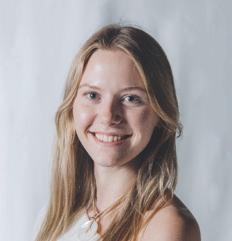 IZZY KAUFMAN BE ORANGE, GO GREEN
IZZY KAUFMAN BE ORANGE, GO GREEN
Whether as paintings, sculptures, photography or music, art has the potential to communicate without saying a single word. The recognition of messaging in art can introduce us to new perspectives, raise awareness of social or global issues and allow the artist to have their unique voice expressed.
Art also breaks communication barriers. For those who struggle with conventional communication due to either social anxiety, or disabilities, art offers an alternative form of self-expression. It also unites speakers of different languages – art is a universal dialect.
Through protest, art can serve as a catalyst for change. Art has been used as a protest tactic for centuries, raising awareness on social and political issues such as suffrage, war, global health issues and now more than ever –ecological issues.
Art protest has ignited awareness in the past and continues to do so increasingly as technology has provided us with yet another medium to express ourselves. Now with social media more present in our lives, there is more opportunity for artists to be recognized and for their audience to see their work. Although viewing street art from your screen seems contradictory, it allows for the art to be spread far and wide.
When Rice University Professor Timothy Morton visited the new “Assembly: Syracuse University Voices on Art and Ecology” exhibition in the Syracuse University Art Museum, he was introduced as an “academic freestyle rapper.” Until he began his presentation, I had no idea what that could possibly mean. Morton covered many ideas during his presentation, but notably, he did not use a single statistic to make his point. His book “Being Ecological,” supports this anti-fact storytelling as a means
to become a good environmental samaritan.
SU Art Museum’s “Assembly” exhibition is a collection of artworks in various mediums, all made by Syracuse University faculty and recent alumni, in conjunction with works of the museum’s collection. The collection notes that ecology is a matter of intimacy; nature is not distinct from humans, rather humans are major players in the world’s ecology.
The exhibition is able to tell the story of nature, ecology and climate change in mediums other than words and numbers. The visual aspect of the exhibition is where its message is strongest. When analyzing the pieces in collaboration, the story comes to life in a way a statistical chart would be unable to.
We are consistently told the same numerical information about climate change, how much carbon dioxide is in the air, how much the temperature has risen and how much time we have left before impacts are irreversible. But how effective is it to be told the same story over and over again? In this sense, Morton’s presentation was a breath of fresh air, talking about what it means to be ecological in a philosophical sense rather than being told you must limit your carbon footprint by “X” tons.
Using mediums rather than numbers to tell stories of the environment, of nature and of climate change make the conversation more accessible to others. Climate conversation can be biased towards those unfamiliar with scientific jargon. There are barriers to understanding the conversation of climate that can be improved by changes in communication tactics, such as improved visualization.
The idea of climate change is so large and occurs at such a slow pace that recognizing the change can be difficult. Morton would refer to climate change as a “hyperobject,” or “ideas with such vast spatial dimensions that defeat the traditional ideas of what the idea is in the first place.”
Although the definition of the term in itself is hard to explain, it helps us understand that we may be able to see evidence of

the hyperobject (i.e., more intense storms), but the totality is hard to be seen. We are experiencing changes that go beyond a human societal level in terms of time and parties impacted.
On Jan. 28 in Paris, two female protesters within “Riposte Alimentaire,” a climate activist group, threw soup on the “Mona Lisa” in The Louvre. The disruption was meant to begin a conversation regarding the sustainability of the agricultural system, a choice that many questioned both for its efficacy and its morality
To intentionally destroy the Mona Lisa would be nothing short of cruel, so activist groups like Riposte Alimentaire have specifically targeted paintings that are protected by a layer of glass. The reasoning behind attacking the Mona Lisa is to not destroy the art, but to disrupt the visual with another visual to portray the idea that without a habitable earth there would be no art.
The first step to taking action against the climate crisis is to talk about it. Whether that is through a typical conversation, or via a form of media bringing your attention to the topic, awareness is key. Art is unique in its ability to spread awareness as it can evoke emotions and spark human connection with the environment more effectively than a data set.
So take the time to visit the “Assembly” exhibit and experiment with different forms of media in understanding nuanced issues and ideas. There are infinite possibilities of self-expression and awareness to be brought through art, and by no means do you have to be a professional to participate. So get creative and be observant of the art that’s all around you.
Izzy Kaufman is a sophomore International Relations and Environment, Sustainability and Policy major as well as the Co-Director of the Student Association’s Sustainability Forum. Her column appears bi-weekly. She can be reached at akaufm08@syr.edu.
dailyorange.com opinion@dailyorange.com 12 february 29, 2024
column
column
flynn ledoux contributing illustrator
The SU Art Museum’s new exhibit, “Assembly” will run from Jan. 25 to May 12. “Assembly” is intended to communicate ecology through art. maxine brackbill photo editor
from page 16 army
The Orange offense registered seven more shots and five more shots on goal than the Black Knights in the first half. SU’s four extra ground balls made a difference in getting some of those off, and none more so than Thomson’s putback. It was a product of the same exact concept that gave English three scores in 30 minutes.
After taking the pick, English’s shot from the wing was saved low. But when it bounced up into the air, Thomson sprang into action for the ricochet to give Syracuse a 3-2 lead.
“I thought Syracuse liked some of their other matchups better,” said Army head coach Joe Alberici on how Spallina was limited. “Watching Joey in the first five games, he was really attacking the cage a lot, a little bit more than what you saw today. I think they liked their matchup for Sam English. He seemed really energized today and was going to the goal a little bit more than what we had seen in the past.”
from page 15 ward
Maurice said Ward can point out specific details that no one else in the family sees, often spoiling the outcome based on a prior minute detail. As she’s taken more classes at SU, her skills have only strengthened.
Ward was a psychology major but could add a second because of college credits she carried over from high school. Ward added forensics to pair with psychology — a common combination for those looking to enter law enforcement.
“The connections between forensic science and psychology are most evident when considering crime as it relates to both perpetrators and victims,” SU’s Forensics
from page 15 fair
Cardinals head coach Jeff Walz was in support of Syracuse’s predictable set, expressing that he preferred to test SU’s supporting cast rather than Fair.
“Syracuse is going to Fair. You all know it, and you still can’t stop her,” Walz said postgame. “And I thought up until the last three and a half minutes, we had done a really good job on making it difficult to get shots off, challenging her shots.”
The next time the two squared off, Legette-Jack tinkered Perkins back into the rotation. She was subbed in for the final 6:45 of the game and helped
The Thomson-English two-man game was virtually unstoppable. It became the bread-andbutter of SU’s offense once it was clear that Spallina would be less of a factor.
Yet, despite the wide array of offensive supplements, it seemed like Mulé provided all of the “wow” factor. In the second quarter, Mulé tightroped the crease line to finish his shot — with no angle — by shoveling it overhead as he fell to the turf. He gave Syracuse its first lead since the middle of the first quarter.
In the second half, Army’s Pilate was draped on Spallina as usual, and the sophomore standout continued to struggle. He failed to get topside multiple times from X and passed out consistently. Spallina only registered one shot through three quarters, which was saved by Matt Chess.
Spallina did get in on the feeding action, though, adding to his nation-leading assist tally (22). Off the dodge, Michael Leo’s feed to Mulé was deflected toward Spallina, who adjusted quickly for a pop pass to Mulé. As the Lehigh transfer closed in on the goal line extended, Mulé wrapped the shot behind his head and off the turf.
Executive Director Kathleen Corrado said in an email to The Daily Orange. “Forensic Psychology applies clinical assessments to issues within the legal justice system.”
At SU, Ward has taken classes like Forensic Pathology, Bloodstain Pattern Analysis and most notably, Firearm and Tool Examination. The course educates students on firearm safety and the history of weapons. For most of the semester, the curriculum consists of learning about weapons from a theoretical angle, including ammunition development, firearm manufacturing, specialized weapons, silencers and altered firearms.
In the final weeks, the course moves from the classroom to the firing range, featuring live demos and, at times, hands-on experience.
the Orange storm back to upset Louisville 73-72.
Legette-Jack said U-of-L shied away from trapping Perkins because she’s “as strong as a mule” and can efficiently run the floor. It allowed Fair to drain a pair of catch-and-shoot 3s, draw a double team while driving and feed Perkins for a crucial go-ahead basket late in the fourth.
Still, Syracuse reverted to its old form with Fair at point throughout SU’s loss to Duke on Feb. 22. The Orange shot a season-low 25%, turned the ball over more times (15) than they made shots (14) and scored the fewest points (45) they’ve ever had in a single game under Legette-Jack.
For the entire contest, Fair was the true point guard while Perkins barely saw the floor. She wasn’t rotating to receive open feeds and instead
Yet, when it mattered most, Spallina just couldn’t be replicated. The offense went stale midway through the third quarter. The two-man game wasn’t saving them either. SU turned the ball over six times in the third, and Army outscored it 5-3, similar to the first period. In both quarters, Spallina had costly turnovers that seemed to lend the Black Knights some momentum.
“We need to help him a little bit more, putting him in positions to get some more opportunities and have some success,” Gait said of Spallina. “I trust him and it’s going to happen for him.”
Syracuse trailed for the majority of the final period and was down by one with four minutes remaining. Even its most reliable concept from the first half felt futile in the fourth. Just like the Orange done countless times before, English took a pick from Thomson on the left wing to get to his spot in the middle of the field. This time, Chess met it in the bottom corner, and the Black Knights retained their lead.
“When you go to a crime scene, you not only have to know how to handle yourself. You have to be aware of what other people are doing as well,” said Matthew Kurimsky, Ward’s professor in the course. “You have to be able to identify unsafe situations so that you can work to correct them.”
Playing for Syracuse, Ward uses a similar mental skill set that she plans to utilize in her career. SU attack Natalie Smith said Ward often rallies the team and points out crucial details after every goal.
Smith says the attack unit views Ward as the “eyes on the field” who sees things others might not. For Ward, working through passing lanes to find open teammates is just like solving puzzles as a detective.
threw errant shots up as her teammates failed to create space around her. Fair scored a game-best 22 points, yet went 7-for-25 from the field.
Kara Lawson’s Blue Devils’ squad crafted an exquisite game plan to stall Fair in the half court. Guards Taina Mair, Oluchi Okananwa and Jadyn Donovan double-teamed Fair on drives and trapped her on the wings. As the primary ball-handler, Fair resorted to forcing errant shots while her teammates struggled to create space.
“We weren’t going to practice tomorrow,” Legette-Jack said after the game, “but we will practice tomorrow because we should have a lot of energy.”
Barreling into March, the Orange are at a
When the Orange are in crunch time, that’s usually when Spallina shines brightest. But this time, Gait called on Owen Hiltz. From the left wing, Hiltz rolled back to get to the middle and his sidearm runner slotted just inside the left post to tie it up 13-13 with 2:28 remaining.
A heroic save from Will Mark with mere seconds left on the clock was Syracuse’s saving grace and forced a second overtime finish in its last three games.
Overtime didn’t improve Spallina’s performance. His fifth shot of the game was a behind-the-back missile off a dodge from X, which sailed over the cage and gave Army the ball back.
Miraculously, SU forced a turnover, but Mulé missed an open-net shot from the 40-yard line. Jackson Eicher scored the game-winner on the ensuing possession and Syracuse players dropped to the turf, having just dropped their second overtime heartbreaker in the Dome in the last three games.
“I love solving problems,” Ward said. “And I think on the field it’s kind of like connecting the dots. And being a police officer or FBI agent, you’re connecting the dots to try to solve crime. So I think the two kind of coincide like that.”
Despite being three years older than his sister, Jalen said he finds himself shaking his head in awe of Ward’s drive and intelligence. Even as a member of the Babylon Fire Department, Ward’s poise leaves him impressed and assures him she’ll shine in her future endeavors.
“Emma is full steam ahead. Nothing is gonna get in her way,” Jalen said. “If you ask her to do a task, the task will be done. There’s no ifs, ands or buts about it.”
amstepan@syr.edu
@AidenStepansky
crossroads with their offensive scheme. The risk of playing Perkins, or other bench guards, seems too severe for Legette-Jack. Despite her success off the bench during a few of SU’s victories, Perkins has limitations as a volume scorer and on defense against more athletic guards.
But with what Syracuse has already experienced when Fair plays off the ball, it may prove to be an enticing tactic if SU wants to augment Fair’s postseason production.
“We can win any kind of way,” Legette-Jack said. “We’d like to have Dyaisha at the two-guard spot, but the other guards got to show up and show me they can play the point.”
ccandrew@syr.edu
@cooper_andrews

dailyorange.com sports@dailyorange.com february 29, 2024 13
wbmiller@syr.edu @wymill07
men’s basketball
Beat writers predict Syracuse will narrowly defeat Louisville
By Daily Orange Sports Staff
For the first time since a five-game winning streak from Dec. 5 to Dec. 30, Syracuse has at least three consecutive victories. SU picked up victories at NC State, and at the JMA Wireless Dome over Notre Dame and Virginia Tech.
In all three games, Syracuse saw leads slowly dwindle but held its ground down the stretch. It’s averaging 86.3 points per game in the last three games, recently dropping 84 on Virginia Tech.
Judah Mintz tallied a game-high 29 points, while three other players scored in double-figures in SU’s final home game of the season.
The Orange now travel for two more regular season games, facing Louisville Saturday. On Feb. 7, Syracuse defeated the Cardinals 94-92 behind Chris Bell’s career-high 30 points and eight 3-pointers.
Here’s how our beat writers think Syracuse (19-10, 10-8 Atlantic Coast Conference) will fare on the road against Louisville (8-20, 3-14 ACC):
Cole Bambini (22-7)
Make it 4
Syracuse 84, Louisville 81
Being the visiting team has resulted in some up and down performances for the Orange. But riding with momentum, I see Syracuse defeating Louisville to pick up its fourth consecutive win.
Louisville is one of the worst teams in the conference, and prior to its game against Duke Wednesday, it had a tough three-game span with losses to Notre Dame, Pittsburgh and Boston College. Syracuse has been riding some strong offensive momentum, scoring at least 80 points in the last three games.
Just like the first matchup, I think this game might come down to the wire. Louisville has nothing really to play for, aside from moving itself up the bottom third of the ACC standings.
from page 16 straughn
Originally assigned to Takeover’s eighth grade team, Straughn rose quickly. He showed up at every practice — even for age groups he didn’t coach — to help out, talk to players and meet their families. He visited gyms around the area, constantly coaxing big names to join.
“I was willing to do anything. Everything and anything,” Straughn said. “Every kid in our organization knew who I was, every parent in our organization knew who I was. I was there every day.”
Gradually, his role increased. He graduated from folding laundry in Atlantic City for the eighth graders and began compiling scouting reports in Las Vegas for Takeover’s 17-and-under squad. Administrative duties — like ordering branded gear and booking hotel rooms — fell to Straughn too.
“I missed a lot of parties — birthday parties, road trips, concerts, family reunions,” Straughn said. “I missed a lot of hanging out.”
All the while, Straughn continued networking. His connections include camp counselor peers from his playing days to top-flight Nike executives.
Syracuse can’t take Louisville lightly, and will need to stop Skyy Clark and Brandon HuntleyHatfield if it sees itself escaping the KFC Yum! Center with a win.
Henry O’Brien (20-9)
Hot streak continues
Syracuse 89, Louisville 81
Even as some bracketologists give SU a shot, the more realistic outcome seems like the NIT, which would be no shame for a program that has been stuck in the mud for the previous two seasons. With another win over Louisville, though, there could be a little more chatter for the Orange.
They are playing some of their most consistent offense of the season, averaging 86.3 points per game over the last three matchups. Syracuse also played quite well at home against Louisville, scoring 94 points, the most it has recorded in an ACC game this season. With Mintz scoring 21 points and Maliq Brown becoming a more proficient passer, SU will have another effective outing.
But instead of playing the cozy confines of the Dome, the Orange must go to the intimidating KFC Yum! Center. OK, maybe the Yum Center isn’t the most intimidating place to play a basketball game, but SU has struggled on the road. What gives me confidence in this three-game win is that Syracuse won in Raleigh over NC State, so expect the hot streak to continue.
Tyler Schiff (23-6)
Time to win out
Syracuse 88 Louisville 85
Though their first matchup garnered a nail-biting 94-92 scoreline, the Orange never looked out of sorts against Louisville. They weathered opposing guard Clark’s 23-point outburst
DMV upon earning the job at Saint Joseph’s in 2019. But he didn’t know where to start. And so began a quest for personnel equipped with a respected presence and vast knowledge of the area. Straughn’s name kept popping up.
Lange — a former head coach at the Naval Academy — initially didn’t realize that his new hire used to work the camps he ran a neardecade ago. Straughn said he’s had a lot of these “full-circle moments.”
Within months of coming on board, Straughn led the effort in flipping former unranked recruit Cameron Brown to Saint Joseph’s. The 6-foot-6 guard was committed to William & Mary but changed his mind after developing a relationship with Straughn. Brown is now a graduate student with the Hawks, ranking ninth all-time in career 3-pointers made at the school.
Straughn’s relentless insistence on picking Lange’s brain resulted in the creation of impressive pregame schemes. A grasp on NBA-style spacing, analytics and how to execute efficient pick-and-roll offenses were digested. Mutual trust developed. While scoping out talent at AAU tournaments, Lange marveled when Straughn memorized pages of rosters and sleuthed

calmly and secured victory on a heads-up play from Mintz and Quadir Copeland.
Like Syracuse has experienced in recent outings, no matchup problems should emerge at the KFC Yum! Center. During the tail end of this season, Brown has held his own against names like Armando Bacot, DJ Burns Jr. and Lynn Kidd. So, Huntley-Hatfield shouldn’t pose too much of a challenge.
ence foe George Washington in 2022. First-year head coach Chris Caputo hired him for an amplified chance at signing top local recruits — just as Lange had done a few seasons prior. Under Caputo, Straughn learned more about the ins and outs of helming a college program and how to build one from the ground up.
In between the lines, Straughn tossed out expired gameplans and implemented a fresh offensive system. Emphasis on utilizing GW’s guard-heavy scorers saw immediate results. That season, the Revolutionaries won 16 games to secure their first winning A-10 record in six years.
“He’s not just a recruiter but he’s a guy that really knows the game and is hard working,” Caputo said. “He’s growing as a coach and has a tremendous feel for players and their development. It’s an absolute home run hire by Syracuse.”
SU head coach Adrian Autry didn’t need much convincing when Straughn started recruiting his son, Trey Autry, to George Washington. When Autry was an assistant under then-head coach Jim Boeheim, Straughn would tip him off about budding talent in the DMV. Conversations over the phone entailed constant back-and-forth
Mintz, who has scored a combined 50 points in his last two games, is on a tear — seemingly fully evolved into a well-rounded floor general. And that’s just one of a plethora of positive signs from SU in the last few weeks. Bell’s hot shooting, J.J. Starling’s shot-creating ability and Copeland’s efficient playmaking will be too much for the Cardinals to overcome.
sports@dailyorange.com
variety of topics. He easily won over Autry’s wife, Andrea, too.
Watching from afar, the quiet lore of Straughn’s personability and relationshipbuilding made sense to Autry now. He was the perfect applicant.
“Without really knowing it, he was interviewing me throughout the course of the previous five years,” Straughn joked. “What type of work ethic, what type of character, what type of coach.”
Somewhere between organizing recruiting visits and keenly surveying the Carmelo K. Anthony Center’s weight room to encourage whoever’s lifting, Straughn’s mind is always racing.
He isn’t worrying about the tardy timing of outbound trains from Baltimore, nor how to navigate unfamiliar streets to pick up his players before practice. Those days — along with blazers, dress shoes and day jobs — are long behind Straughn. He prefers sweatsuits now.
Typically, practice begins in the late afternoon — and on game days — shootaround commences at 12:30 p.m. When the necessary details are ironed out and each crease is attended to, Straughn sees it fit to
Not in that trusty Nissan Altima, but in a Jeep
“Stay the course, keep the main thing the main thing, and be a guy of strong character, value relationships,” Straughn said. “Through the experiences I’ll continue to gain, I’ll be able trschiff@syr.edu @thetylerschiff


dailyorange.com sports@dailyorange.com 14 february 29, 2024
brenden straughn was hired as an assistant coach at Syracuse in March 2023, when Adrian Autry picked him to join his inaugural staff. Straughn was most recently an assistant coach at George Washington, which finished with its program’s best regular-season record ever in 2022-23. courtesy of su athletics
Our beat writers believe Syracuse will improve its winning streak to four games and complete a season-sweep over Louisville. aidan groeling staff photographer
Emma Ward hopes to join FBI after SU career
By Aiden Stepansky asst. sports editor
Emma Ward’s interest in joining the Federal Bureau of Investigation came from watching “The Blacklist,” an American crime series thriller on NBC.
While recovering from her second ACL tear in consecutive years, all Ward could do was stay in her bed in Babylon, New York. She couldn’t play lacrosse and needed a way to stay entertained. So, like any other 16-year-old, Ward resorted to watching Netflix.
She scrolled through the selection but decided to watch reruns of her favorite show. The dramafilled encounters of Elizabeth Keen (played by Megan Boone) and Raymond Reddington (played by James Spader) captured Ward’s attention and acted as “her therapy,” according to Ward’s father, Maurice.
She knew the television series wasn’t entirely realistic, but she was enticed by its thrilling lifestyle.
“She’s definitely not a person that can sit at a desk,” said Jalen, Ward’s older brother.
“She always has to be moving around or doing something.”
Ward is known for her work on the field, scoring 183 points in her first three seasons with Syracuse. Yet, she hopes to one day be known for her work as a special agent in the FBI. Lacrosse is still Ward’s main focus, but at SU, she’s delved deeper toward her off-the-field goals.
Ward’s interest in the career path was enhanced by watching television, but it also stems from her uncle, Ed Tracy. After decades in law enforcement as a border patrol officer, Tray is now a special agent with the Drug Enforcement Administration.
He often shared unique stories with Ward and Jalen when they were younger, grabbing Ward’s attention with his ability to travel and complete unique daily tasks. Now as an SU senior, she often picks Tracy’s brain to squeeze out any information from him.
“Throughout the years, she’s seen things that I’ve been involved in and I think that there’s an excitement about it,” Tracy said. “I’ve done
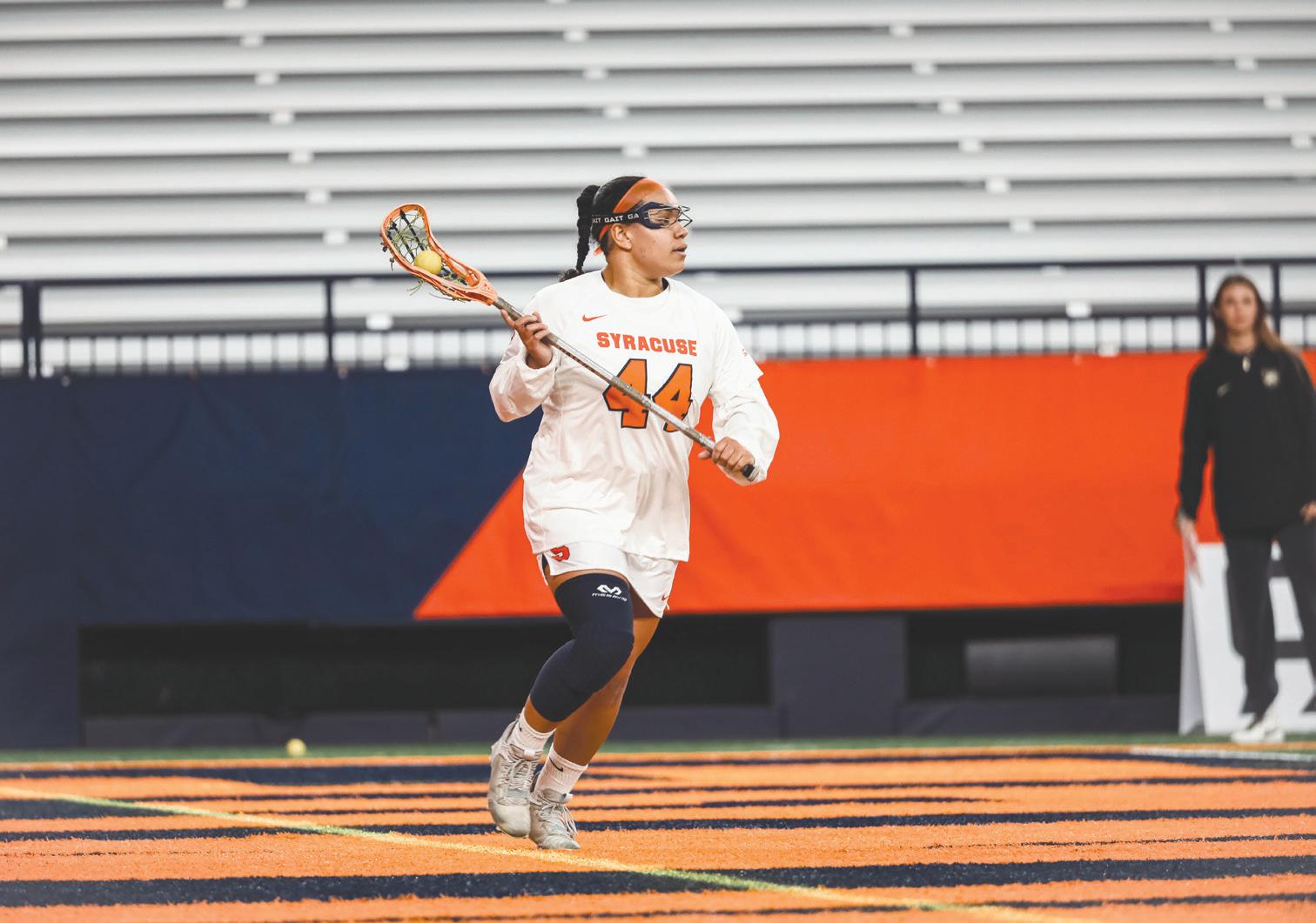
so many different things and they change every single day. I think that’s something that definitely interested her in pursuing this field of law enforcement.”
Law enforcement figures have been everpresent in Ward’s life. Maurice served in the military directly after high school and two close neighbors and family friends serve as officers in the Suffolk County and Nassau County Police Departments. According to her father, Ward’s environment has shaped her thought process.
“She’s always two or three steps ahead,” Maurice said. “On the lacrosse field, in the classroom or whatever it is. She just has this neat ability to see things.”
For a field that requires constant attention to detail and activity, Ward has no shortage of energy. As a young athlete, she bounced around town and rarely sat at home. Ward’s mother, Jaqui, said she often went from one
lacrosse practice to another and even tested her physicality by playing football.
“I could never see myself sitting in a lab or behind a desk and that’s where wanting to be an agent came in,” Ward said. “I want to be out in the field doing field work and things of that nature.”
In high school, when Ward had time to relax with her family, she often indulged in television shows based around criminal investigations. Besides “The Blacklist,” shows like “Criminal Minds,” “NCIS,” “Law and Order,” and “Chicago P.D.” captivated her.
According to her family members, when Ward is home from Syracuse, they watch “On Patrol: Live,” a reality TV docu-series that follows law enforcement agencies around the United States, every Friday night. Ward treats it as a test of her skills rather than a form of entertainment.
Everything to know about No. 12 NC State
By Zak Wolf asst. sports editor
After five straight wins, Syracuse seemed to be hitting its stride down the final stretch of the regular season. But the Orange put in its worst offensive performance of the season against Duke in a 58-45 loss.
What followed was a close win versus Pittsburgh, which ranks last in the Atlantic Coast Conference. SU trailed by eight heading into the fourth quarter, but Dyaisha Fair took over, scoring 15 of her team-high 23 points in the fourth quarter — where the Orange outscored Pitt 22-4.
The win over Pittsburgh tied a Syracuse program record for regular season wins. The only team standing in its way of breaking that record is North Carolina State, a known powerhouse in the Atlantic Coast Conference. The Wolfpack have won the conference regular season title on four separate occasions, including in 2021-22.
Here’s everything to know about No. 12 NC State (23-5, 11-5 ACC) before it takes on No. 19 Syracuse (23-5, 13-4 ACC):
All-time series NC State leads 11-4.
The last time they played… Syracuse suffered its worst loss of 2022-23 as NC State defeated the Orange 83-58 in the second round of the ACC tournament. SU entered the game on the bubble of the NCAA tournament and needed a win to have a shot at possibly making the 68-team field. What ensued was a disastrous performance in a must-win scenario.
Fair scored just 11 points — her second-lowest total of the season — on 4-for-17 shooting. Teisha Heyman, Georgia Woolley and Dariuana Lewis all finished in double figures, which kept Syracuse in the game throughout the first half.
The Wolfpack Report
For the first time all season, NC State is coming off back-to-back losses after it fell to North Carolina and Duke. Over the last two games, the Wolfpack combined to shoot 34.3% from the field, including a season-low 58-point effort against the Blue Devils. They fell 17.4 points short of their season average of 75.4, which is
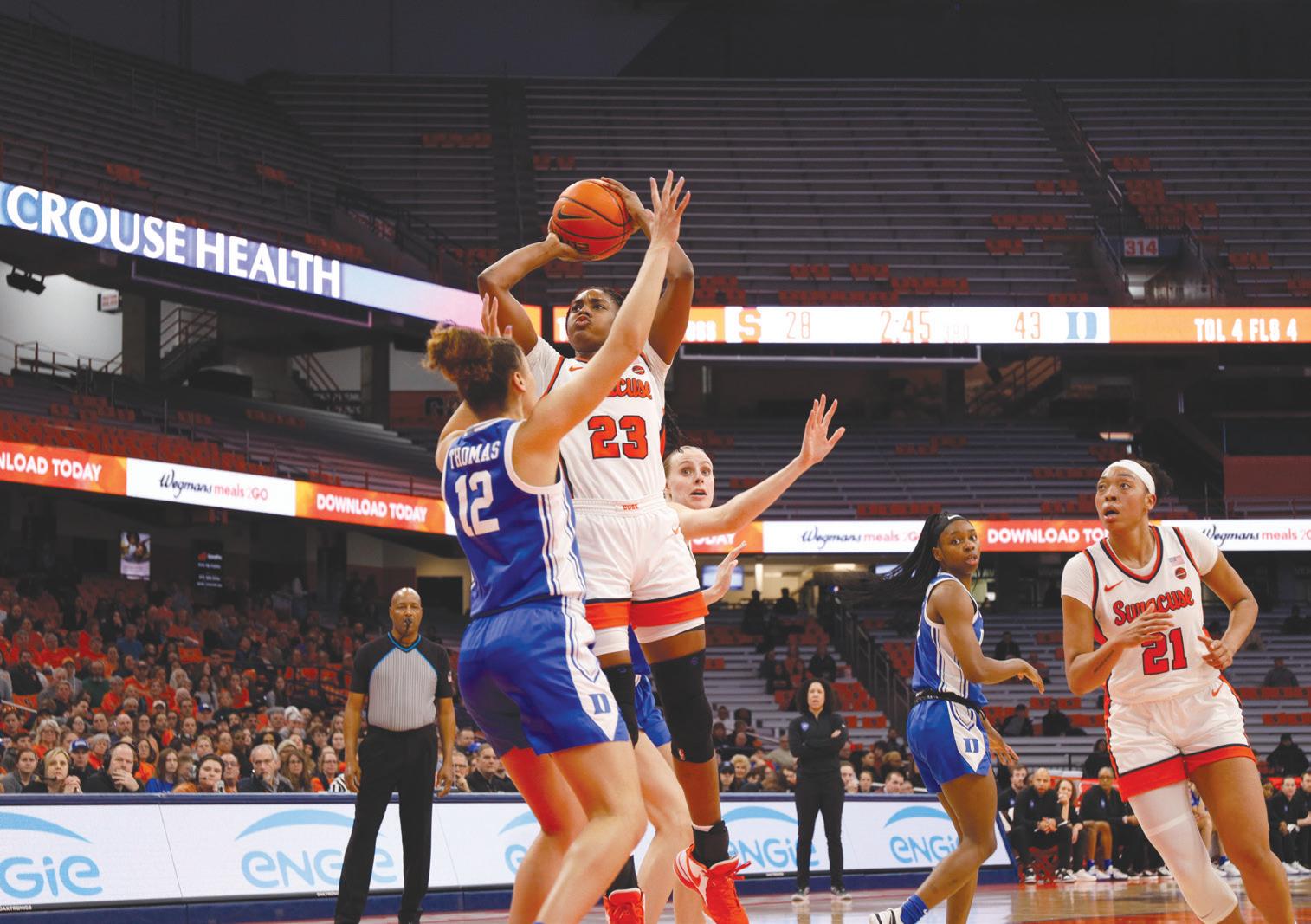
the 34th-best mark in the country, according to HerHoopStats.
But what sets NC State apart is its lockdown defense. Per HerHoopStats, the Wolfpack hold their opponents to the 14th-lowest shooting total in the country (36.1%). NC State limits its opponents to 60.8 points per game, the fourth-best mark in the ACC. Though, the Wolfpack don’t play an aggressive brand of defense, ranking outside of the top 200 in Division I with 6.9 steals per game.
How Syracuse beats NC State
The Orange have the chance to make one final statement in the regular season after showing they can compete with the top dogs in the ACC. But they have to play their game, or else the Wolfpack could run away in the contest.
Not to beat a dead horse, but Syracuse has to start strong against NC State. It can’t afford to fall behind by 17 in the first half like it did against Duke. While the Orange have shown they can come back this season, doing it on the road will be a tall task. If SU can keep the score close heading into the fourth quarter, it can let Fair do what she does best — take over games.
Stat to know: 31.7 defensive rebounds per game
NC State averages 31.7 defensive rebounds per game, which ranks first in the country. The Wolfpack’s strong presence on the glass means it’s going to be a battle on the boards against SU. The Orange average 16.1 offensive rebounds per game, which is the most in the ACC and fourth most in the country, according to HerHoopStats.
Player to watch: Aziaha James, guard, No. 10
James has slowly become the No. 1 option for NC State after two seasons of being a role player. James made the ACC All-Freshman Team in 2021-22 and then averaged 6.8 points per game in 2022-23. But this year, James has taken her game to a different level, leading NC State with 16 points per game.
Over James’ first two seasons, she finished in double figures just 10 times. This year, she’s done it 22 times, highlighted by her career-high 33 points on Jan. 21 against Duke. In games where James scores at least 20 points, NC State is 5-2.
zakwolf784254@gmail.com
@ZakWolf22
women’s basketball
‘Free Dyaisha’ unlocks SU offense
By Cooper Andrews sports editor
Considering the rigorous workload that’s placed upon Dyaisha Fair each game, you’d think Syracuse has a predictable, onedimensional offense. So, what’s the secret for SU to consistently display its full offensive potential? Taking the ball out of its star’s hands.
Fair drops 21.8 points per game, has made the third-most 3s in the country with 99 — 31 more than the next-closest Atlantic Coast Conference player. She also sports 4.2 offensive win shares, the eighth-most in the nation, per HerHoopStats.
The opposition’s common response is exhausting all options to thwart Syracuse’s most dangerous artillery. Fair often faces traps at the top of the key and is sometimes face-guarded in a full-court press. Head coach Felisha Legette-Jack has recognized this scheme, adapting by playing Fair off the ball to generate more open shots.
“It does free her up a little bit to be a two (guard) and kind of see the game differently,” Legette-Jack said on Feb. 28. “Having to control the ball, deal with two people trapping her and also running the team, that’s a hard thing to do.”
28%
“When she plays off the ball, it kind of frees her up and oh boy, we’ll have ‘Free Dyaisha.’”
But Legette-Jack wants “Free Dyaisha” to become a staple for No. 19 Syracuse (23-5, 13-4 ACC). The strategy allows Fair to roam around the perimeter and receive plentiful catch-and-shoot chances. Comeback wins over then-No. 15 Florida State and then-No. 15 Louisville were games where Fair ruled the fourth quarter and showed SU’s poise when she wasn’t the primary ball handler.
The Orange have recently been dull in halfcourt sets where Fair is the traditional point, with the lowlights being in losses to then-No. 19 VT and Duke. Legette-Jack pinpointed her team’s lacking guard depth as the issue, which forces Fair to run point in most outings.
“You don’t get to be on the court if you don’t earn it, and that’s what we’ve been dealing with,” Legette-Jack said. “And as soon as those young ladies decide that they’re going to show up in practice, then they’ll show up in the game and ‘Free Dyaisha’ earlier.”
Legette-Jack didn’t clarify who she was chastising. But over the last handful of games, she’s slashed the playing time of Kennedi Perkins, her main bench point guard option.
Perkins hasn’t played more than 10 minutes since playing 22 minutes on Jan. 18 versus FSU — where she put up nine points and three assists at the two alongside Fair.
Fair drained a program-record nine 3-pointers against the Seminoles, curling around picks and unleashing from the wings. She dropped 11 of her 31 points in the fourth, all while Perkins was playing, as the Orange completed an 18-point comeback.
The lineup first shined through SU’s historic come-from-behind win over Clemson. After the Orange trailed by as much as 19, Fair dropped 14 points in the fourth quarter to take an advantage late. Perkins was in during 11 of Fair’s 14, helping space the floor to draw open looks for the star guard.
Yet in her next six appearances, Perkins failed to warrant more than 10 minutes of playing time. She saw the court for just three minutes in an 81-69 loss at Louisville on Feb. 1. Fair was back to being the main point and struggled for the first three quarters, shooting 4-for-11 from the field. She was trapped around the perimeter, making just one of four attempts from 3 before the fourth quarter. Fair tallied 15 points in the fourth, but the game was already out of reach.
dailyorange.com sports@dailyorange.com february 29, 2024 15
women’s lacrosse
women’s basketball
emma ward excels on the lacrosse field as Syracuse’s facilitator. In the future, she wants to use her mind to help solve high-profile cases in the FBI. joe zhao asst. photo editor
see fair page
SU takes on NC State in its final regular-season game. It’s the pair’s first meeting since the Wolfpack defeated SU in the 2023 ACC Tournament. nick luttrell staff photographer
see ward page 13
13
Dyaisha Fair shot just 7-for-25 from the field in Syracuse’s loss to Duke, playing as a traditional point guard the whole game.
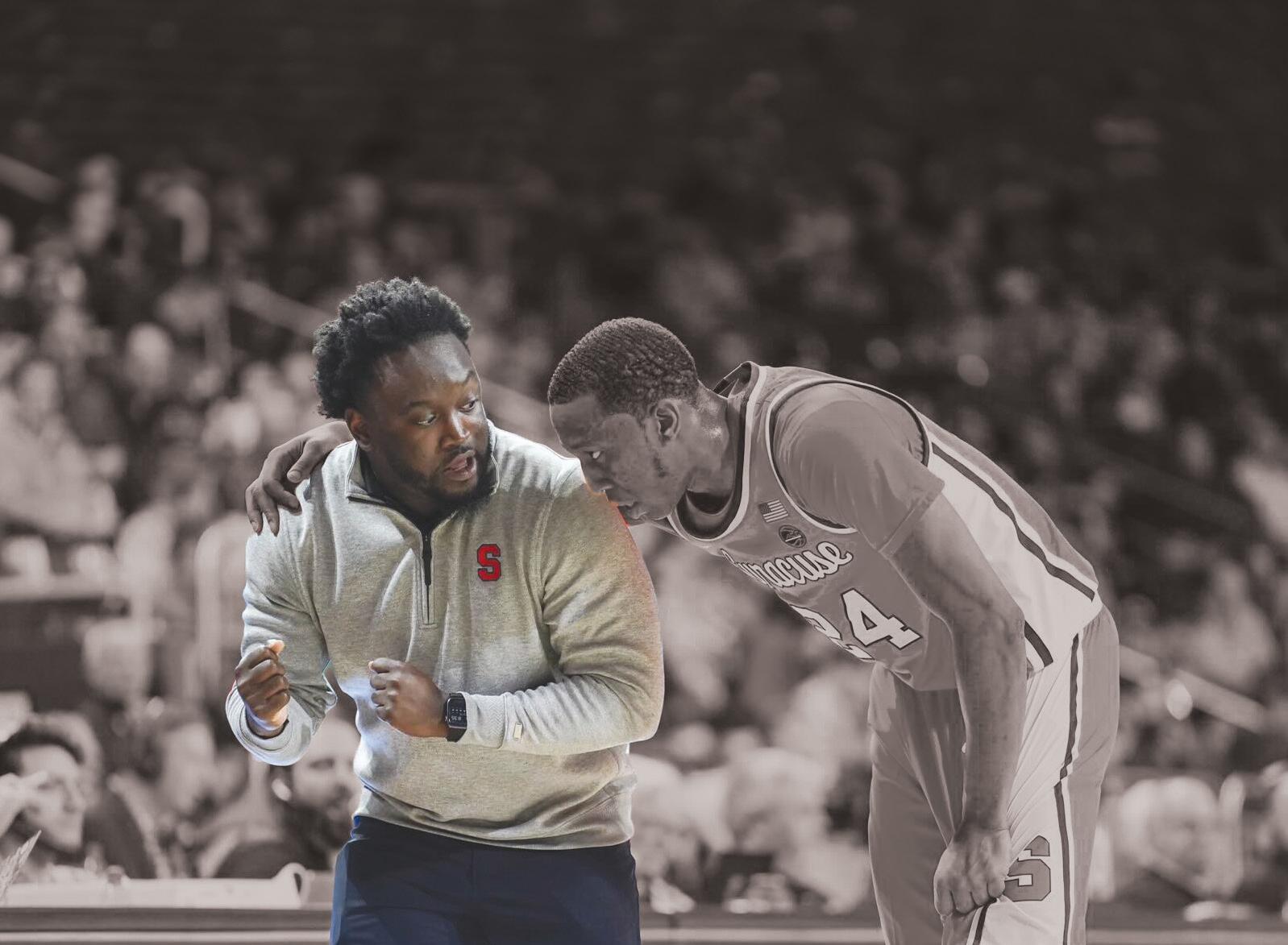
‘HOME RUN HIRE’
Brenden Straughn’s rapid rise through college basketball’s coaching ranks stems from the 33-year-old’s ability to recruit
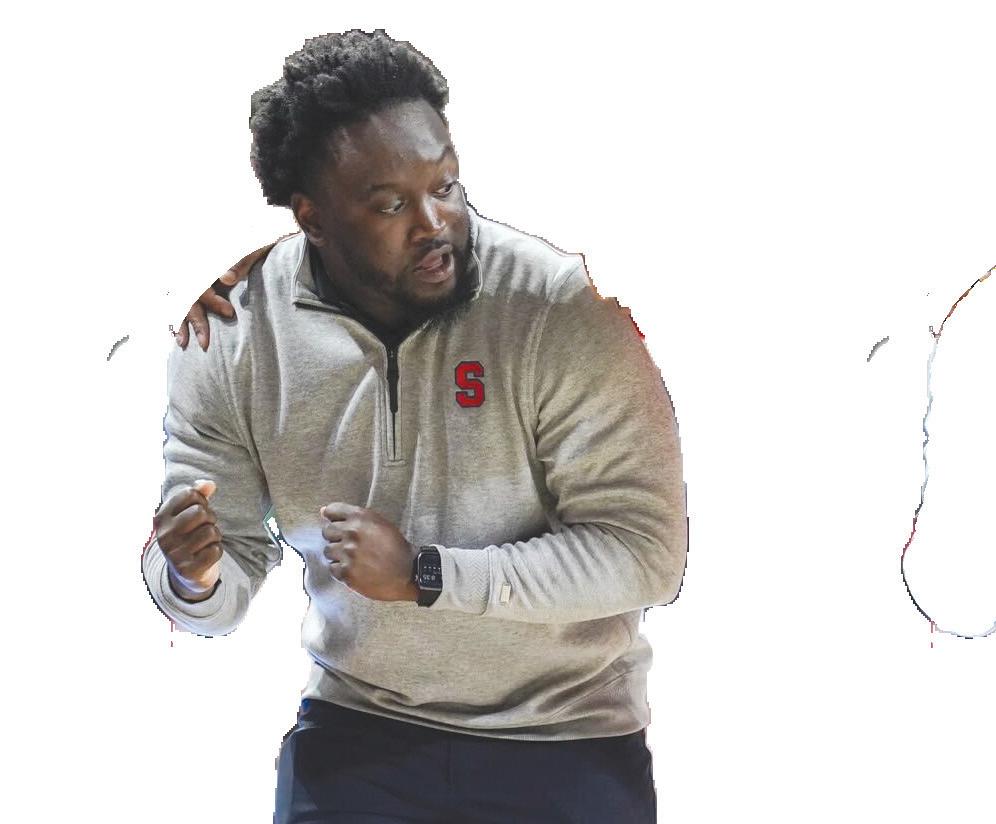
I was willing to do anything. Everything and anything. Every kid in our organization knew who I was, every parent in our organization knew who I was. I was there every day.
By Tyler Schiff senior staff writer
It’s just before 5 p.m. when Brenden Straughn squeezes back into his 2005 Nissan Altima.
It’s 2016 and Straughn’s been awake for 11 hours — nine of which were spent in a cubicle — with practice starting soon. A clutter of shoe boxes, jerseys and basketball-filled duffel bags occupy a crowded trunk, making up most of each session’s essentials. The rest have to be picked up.
As a then-26-year-old assistant coach for Eleanor Roosevelt High School (Maryland), Straughn begins roaming the Washington metropolitan area for players needing a ride. His route is ever-changing, but Straughn rarely arrives late to practice. He coaches until 9 p.m., then stays behind for individual workout drills, knowing full well tomorrow’s alarm goes off at 6 a.m.
Yet, there’s a special type of solace in staying the course and maintaining one routine, Straughn
Brenden Straughn
su assistant coach
said. It helped him consistently go the extra mile and get ahead.
Ask anyone today ‘Why Brenden?’ and you’ll get the same answer. Coaches clamor after his ability to recruit the Washington metropolitan — or “DMV” — area and his intricate attention to on-court detail on either side of the ball. They’re charmed by his confident feel for the game and simultaneous humility. Those who seek his one-off opinion often come back for more. He’s also a master evaluator of talent, they say.
The seemingly infinite list of praise-worthy qualities remains endless. And few are shocked that he’s an assistant at Syracuse on the cusp of turning 34.
“He’s got the IQ, he’s got the work ethic, he’s got the personality and soft skills that you need,” former Eleanor Roosevelt head coach Brendan O’Connell said. “So no, I’m not surprised.”
Straughn’s yearn to coach stemmed from a pursuit to rediscover the rush of competition. It’s what he
relished most during his four-year playing career at Division III Hood College (Maryland).
During offseasons, between pick-up games at neighboring campuses and local gyms to stay in shape, Straughn began working camps for pocket change. He’d pick up a couple hundred dollars each week participating in clinics at the University of Maryland and the Naval Academy.
Then came the real world after school ended — a day job at wealth management firm Merill Lynch in Baltimore. Athletic shorts were swapped out for dress pants, but he refused to retire his coaching whistle.
Straughn’s 9-to-5 never got in the way of his initial coaching stints at Eleanor Roosevelt and Team Takeover, a local AAU powerhouse. Essentially a volunteer for both teams, he’d use the steady pay at Merrill Lynch to fund any basketball-related ventures. Gas, flights and train tickets came out of his own pocket.
Straughn remembered saving all of his paid time off for when Takeover traveled to summer tournaments.
see straughn page 14
Joey Spallina held scoreless in SU’s overtime loss to Army
By Wyatt Miller senior staff writer
Two uncharacteristic Joey Spallina turnovers led directly to Army’s first two scores of the game.
The first pass Spallina tried to force through the defense was from X and picked off cleanly by Army’s AJ Pilate. On the other end, Jacob Morin answered immediately with a low-to-high rocket from the outside, assisted by Reese Burek. The goal occurred just 17 seconds after Spallina’s turnover, catching the Orange’s defense sleeping on their slides.
Minutes later, Spallina tried to thread the needle again, only to achieve the same result. His skip pass was snatched by Ned Lynch, who celebrated emphatically near the sideline as the ball was cleared. Twenty-one seconds later, Burek had found the back of the net to tie the game at 3-3.
By the end of the first half, Spallina totaled three turnovers, more than he had in all of SU’s first four games. Two of them resulted in quick points for the Black Knights, and Syracuse’s offense was sluggish out of the gate as a result
of Spallina’s ineptitude. He’s now tallied no goals in the first half against both ranked opponents SU has faced and had zero first-half shots Wednesday. “I think he’d like to have a do-over on it,” Syracuse head coach Gary Gait said. “There’s just so much pressure on him right now. It makes it so difficult when a young player like that has that incredible pressure. So we have to help him figure out the keys to success... He’s going to figure it out in these tough games. I believe in him.”
No. 7 Syracuse (4-2, 0-0 ACC) fell 14-13 in overtime to No. 5 Army (4-0, 0-0 Patriot League) behind a struggling Spallina. In his stead, other Syracuse playmakers stepped up to compete against the 10th-best scoring defense in the nation, but to no avail. Sam English scored three unassisted, first-half sweepers on the same concept, while Finn Thomson added an alley-oop score and an assist. Jackson Birtwistle and Christian Mulé added a hat trick each, but SU’s offense fell flat in the second half, losing its second-straight overtime game to a ranked opponent.
English started the scoring by clearing Thomson and his defender before stepping down from straight ahead. The Orange drew first blood just over a minute into the game and the Princeton transfer set his Syracuse career-high in goals after totaling just five to start the year.
“(English) was dodging hard, he was going to the goal, and I think that provided opportunities,” Gait said. “He came out ready to play today... He played everywhere today.”
see army page 13
SPORTS dailyorange.com sports@dailyorange.com 16 february 29, 2024
men’s lacrosse
Few are surprised that 33-year-old Brenden Straughn is an assistant at Syracuse due to his respected presence and exceptional basketball mind. Adrian Autry hired Straughn because of his success recruiting in the DMV, and he’s set to continue the program’s strong pipeline to the region. courtesy of su athletics

















 Story by Ava Lombardi asst. copy editor
Photos by Cassandra Roshu photo editor
Story by Ava Lombardi asst. copy editor
Photos by Cassandra Roshu photo editor









 SOFIA AGUILAR
SOFIA AGUILAR

 EMANE HAQUE FEMSPLAINED.
EMANE HAQUE FEMSPLAINED.

 IZZY KAUFMAN BE ORANGE, GO GREEN
IZZY KAUFMAN BE ORANGE, GO GREEN








